Are Dating Apps Producing Incels?
The societal devastation that a growing number of people believe dating apps are responsible for can’t be understated. They are the death star of the modern dating market, with chad its Darth Vader. The basic idea is that these apps have granted women easy ‘access’ to highly physically attractive men, by providing a convenient and discrete method for ordering ‘chads’ to their house like pizza. They have facilitated women’s ‘hypergamous’ (a term that’s been mangled beyond recognition) nature, and again, this is having disastrous effects. It is generating immense resentment and frustration among men. It is directly responsible for the so-called ‘male sexlessness epidemic’, as it has led to a ‘winner-takes-all’ scenario whereby a small minority (the top 20-1% depending on who you ask or how they’re feeling at that moment) of men are increasingly monopolizing the sexual marketplace, while the majority of men are left fighting tooth and nail over scraps. And once women have had a taste of ‘chad’, so the story goes, they refuse to settle for anything less. This is in turn leading to men ‘dropping out of society’ as they don’t see any purpose in contributing to a society in which they are locked out of said marketplace. According to a YouTube video by former self-improvement guru turned black-pill sociologist, the consequences are so catastrophic that it has a good chance of leading to an all out civil war as incels decide enough is enough and decide to violently revolt. So this should give you an idea as to the stakes involved.
It would be a mistake to simply dismiss this as a fringe incel view however. It has been garnering a fair amount of traction as of late, for instance being promoted by a guest on Real Time with Bill Maher – he also appeared on CNN following the viral Pew survey to repeat the same talking points, and by the YouTuber Shoe0nHead on Breaking Points while she was making the rounds after publishing her viral ‘Male Loneliness Epidemic’ video. I wouldn’t be surprised to see dating apps next on the chopping block after tiktok with a strong push to ban them emerging in the near future due to this widespread perception. This narrative, henceforth ‘TTN’ (The Tinder Narrative), has penetrated the ‘normiesphere’ to where I feel it deserves a serious response. One which I haven’t seen it receive and which I will attempt to use the information I’ve accumulated to establish a more nuanced picture.
So, what is the main factor driving this view then? A simple answer is that it is genuinely a highly rigged environment where many men are SOL. They struggle to get any matches, let alone arrange a date. We’ve all seen the data showing that women are highly selective with their swipes compared to men. It becomes quite a lot more of a pleasant experience however the more physically attractive you are. This much is true. We don’t need any more ‘chadfish experiments’ demonstrating this. It’s not hard to see why this would lead to much frustration and also be degrading to one’s self-esteem. So should we pack it up and go home then? Does this confirm their argument, and any opposition must simply be a manifestation of ‘cope’, or is there more to the story?
- The Gender Ratio
- The Effects Of Attractiveness
- Actual Outcomes
- “But We Can’t Trust Self-Reported Data!”
- Most Men Quite Like Online Dating
- Why Should We Even Expect This?
- Conclusion
The gender ratio of dating apps
The first thing we have to recognize is that contrary to the assertion by the Bill Maher guest that there is an even split of men and women using these apps, it’s well established at this point that the gender ratio of these apps tends to be highly skewed. According to this 2020 Morning Consult poll, roughly 9% of men and 3% of women were currently using an online dating app or website, translating to a 3:1 ratio.
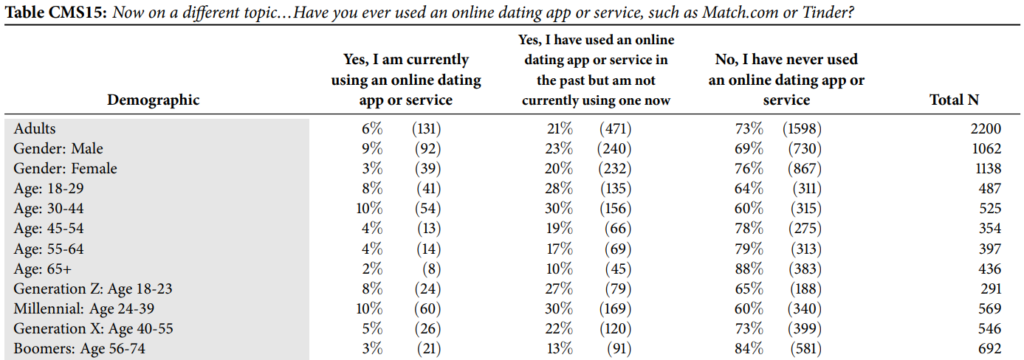
Of course the rate was higher for younger participants, but maybe less than you’d expect, with the overall rate rising from 6% to 8% for Zoomers and to 10% for Millennials, with more than half of them never once having touched a dating app or website.
When it came to people who had ever used it before, the proportions were a lot closer, with roughly 31% of men and 24% of women reporting having used one overall. The turnover rate is therefore higher for women, meaning this isn’t the strongest counter-argument on its own, as promoters of TTN could claim that they are leaving the apps after they promptly find a ‘chad harem’ to join.
On the other hand when respondents in a 2018 Morning Consult poll were asked why they stopped using various online dating apps and services, only about 15-20% of women (no more than men) reported it was because they ‘met someone online and don’t need it anymore’:



These are the usage rates when it comes to Tinder in particular, the app where most of the focus tends to be directed towards:

The proportion of women (60%) compared to men (47%) who’d never used Tinder before was higher even among this subsample with online dating experience, perhaps due to its hookup reputation.
Another source found in a study conducted between October to December of 2018 of apparently 12 million dating app users across the US and Europe again a ratio of approximately 3:1 men to women users in the US, and if you thought it was bad there it found even more skewed ratios in European countries, up to 10:1 in Italy.

It shouldn’t be hard to see why by dating app companies aren’t eager to release this data to the public. This fact alone means that it’s inevitable that the majority of men are going to struggle to find a date, unless I guess ‘Stacy harems’ were on the table.
I believe that much of the perception around dating apps is coloured by the implicit assumption that the dating app population basically mirrors real life, as unlike in a bar or a club for instance, we can’t physically see that there aren’t many women around. In fact all most people see is the opposite sex.
There was also an elo system in place whereby more popular profiles would be prioritized, though they assure us it’s a thing of the past.
I guess we’ll have to see if it makes any difference. Paid users however are of course still prioritized:
Want to increase your chances of getting a match? Priority Likes is a feature exclusive to Tinder Platinum subscribers that helps to make sure your Likes and Super Likes are seen faster by a potential match, before the Likes of non-subscribers.
So if you don’t want to cave in and let the company profit off your desperation then you’re at an even greater disadvantage.
This gender imbalance no doubt has a heavy impact on swiping behaviour. The more of a sausagefest it is, the more liberally men will swipe as competition becomes more fierce. This in turn will presumably have the effect of incentivizing greater selectivity among women as more of their swipes will result in a match. Men get increasingly desperate, and the cycle continues. Many men will choose to adopt a spray and pray method as they decide applying any selectivity is wasted effort. Women may become overwhelmed and leave, exacerbating the effect. I believe the gender ratio wasn’t quite as imbalanced in the past.
More men also report hookups as a motivation for their dating app usage, which they are likely willing to lower their standards for.
Also, since the data can’t show us any truly undesired matches being filtered out afterwards, this may give swiping data alone a somewhat false impression.
Messaging & the effect of attractiveness
As I mentioned, this is one of those meme graphs that everyone’s seen by now:
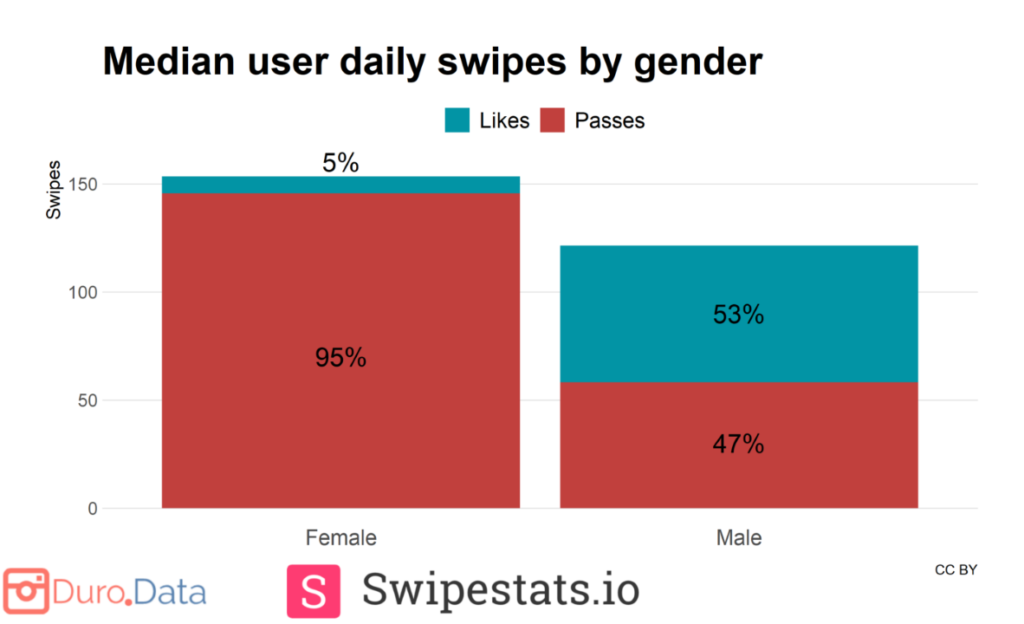
There are a couple of other charts from this article though (which conveniently seem to be behind a paywall now) that are helpful in determining whether the extrapolations from this data are in fact warranted. First off, we have this one showing median daily matches:
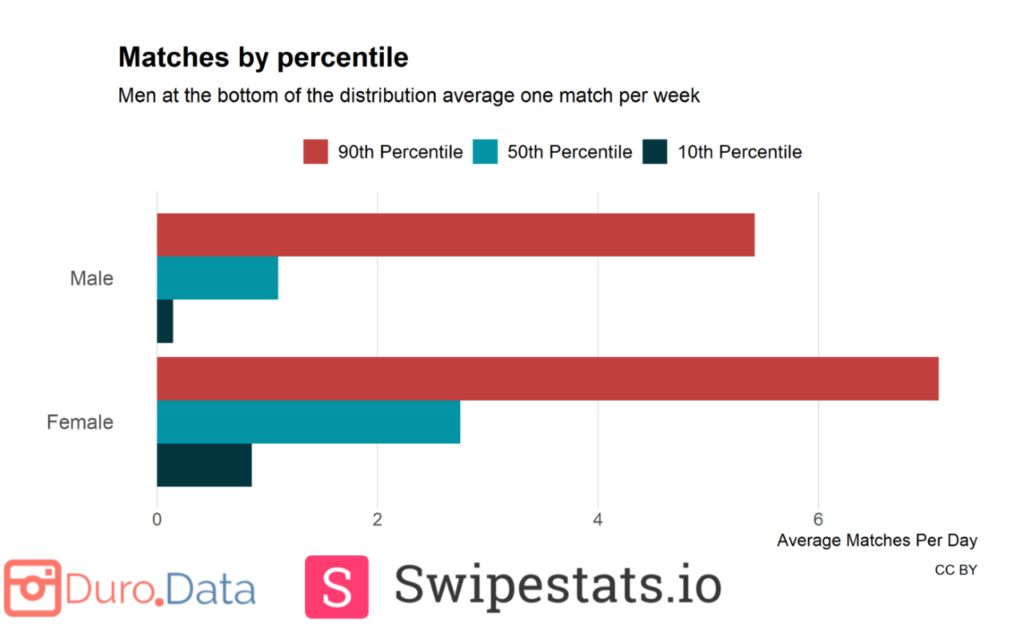
While the 50th percentile of men (i.e. the ‘average’) got about one match a day, the average woman got around 2.7. On the surface this seems imbalanced, but we have to remember that men outnumber women by about 3 to 1 (they reported a similar ratio in the dataset they analyzed). What’s interesting is that if you take this into consideration, this imbalance in matches evaporates, as based on this fact alone you’d expect the average woman to get about 3x as many matches. On the other hand this fact goes against TTN which would predict the average man to have proportionally fewer matches than the average woman, as they were being almost completely ignored in favour of the top 20-5% of men, while these top men supposedly don’t mind reaching down for women significantly below their own attractiveness.
Still, it remains the case that some men are a lot more successful than others, and women’s match rates may be more self-restricted.
So do women behave uniquely ‘superficially’ in the online dating environment? A more direct way to measure this would be to look at who is messaging who and how much these messages are influenced by the attractiveness of the sender and the receiver. Luckily, multiple studies have done just this for us.
Another source is the OKCupid blogpost from which this infamous graph is plucked from out of context:
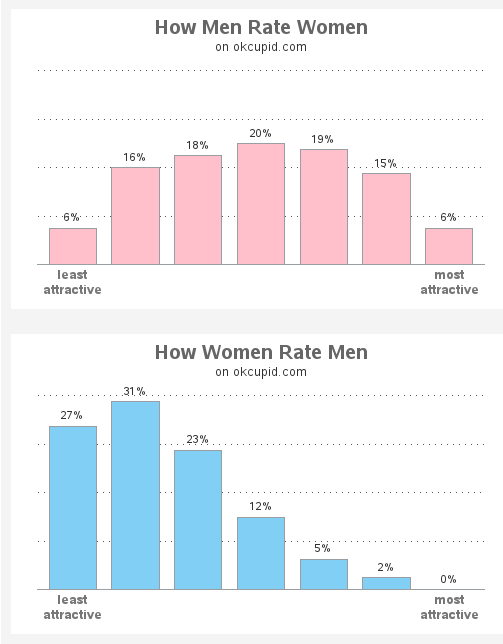
Much less popular are these graphs showing how these ratings relate to actual messaging behaviour. Look at what they do, not what they say, right?
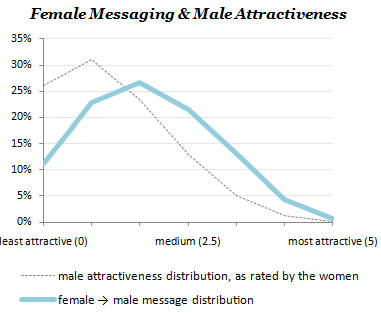

It turns out that most of women’s actual messages went to men rated below the midpoint of 2.5. Now obviously since the ratings represent something different on either graph, this isn’t to say that women are far less influenced by attractiveness or that they somehow prefer below average looking men.
They also produced a couple of graphs which showed the number of messages received by attractiveness, measured by how many times more people of particular ratings were messaged relative to those rated 0 while controlling for the number of ratings, and the percentage of messages which received a reply by the sender’s attractiveness.
In neither case do we see a stronger effect of attractiveness on women’s messaging behaviour, if anything it’s the reverse, although there’s less of a gap when it comes to reply rates which is probably a more meaningful metric since men are the primary initiators.
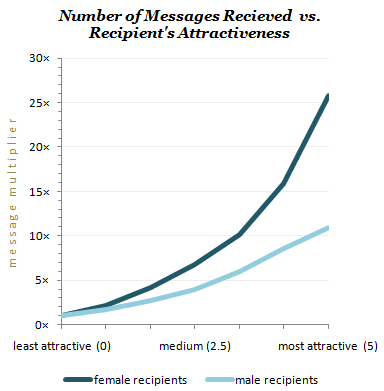
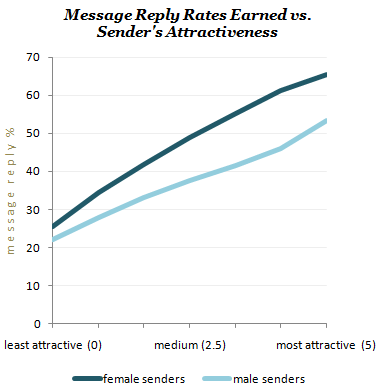
As for the ratings themselves, this dataset is actually quite anomalous. While women are consistently rated higher by both men and women, in other datasets from speed-dating studies and more controlled experiments the means and distributions are a lot closer between the genders. This is probably another one of those topics that would need its own article however, so moving on…
A since deleted Hinge report showed these distributions of likes for men and women. As we see, the inequality within each gender isn’t wildly different.
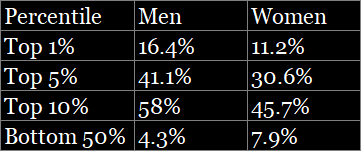
The gender ratio on this app seems a bit more balanced, 57% male according to the 2018 Morning Consult poll, and 63% according to the 2020 one, but it’s still probably enough to explain a good amount of the disparity that does exist.
A study by Bruch & Newman (2018), titled: ‘Aspirational pursuit of mates in online dating markets’, analyzed data from an online dating service across four US cities. They measured desirability by how many messages users got, and how desirable those message senders themselves were. The below graph shows messages sent and replies received as a function of the ‘desirability gap’. A value of 1 would represent the least desirable man or woman sending a message to the most desirable person of the opposite sex.
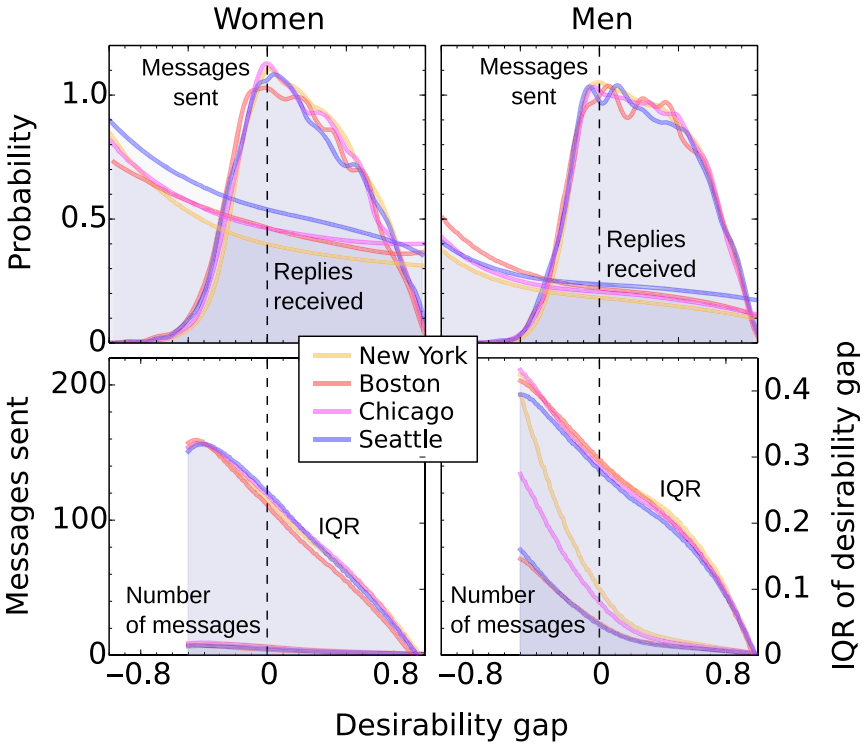
The most common targets for both men and women were people of roughly equal desirability to themselves. The distributions however were of course skewed, with men on average sending messages to people 26% further up in desirability rank than themselves and women 23% further up. We see the typical pattern whereby men sent more messages and received less replies, but the moderating effect of desirability on replies received was again similar for both genders.
Finally, a study by Egebark et al. (2021) titled: ‘Brains or Beauty: Causal Evidence on the Returns to Education and Attractiveness in the Online Dating Market’, created fake online dating profiles with manipulated attractiveness and education levels, essentially a ‘chadfish experiment’, and sent random invitations for a serious relationship.
This study found that while women again received much higher response rates, the effect of attractiveness on the likelihood of response didn’t differ by gender.
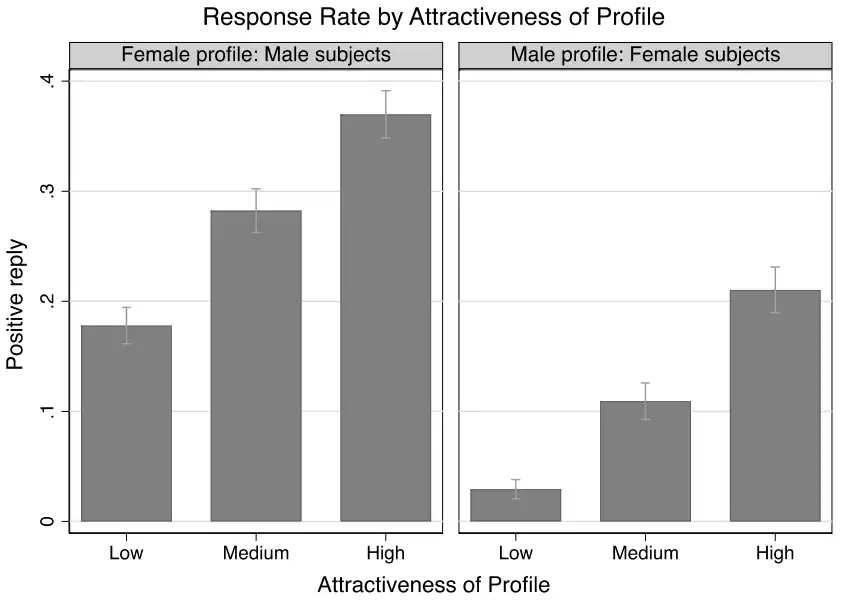
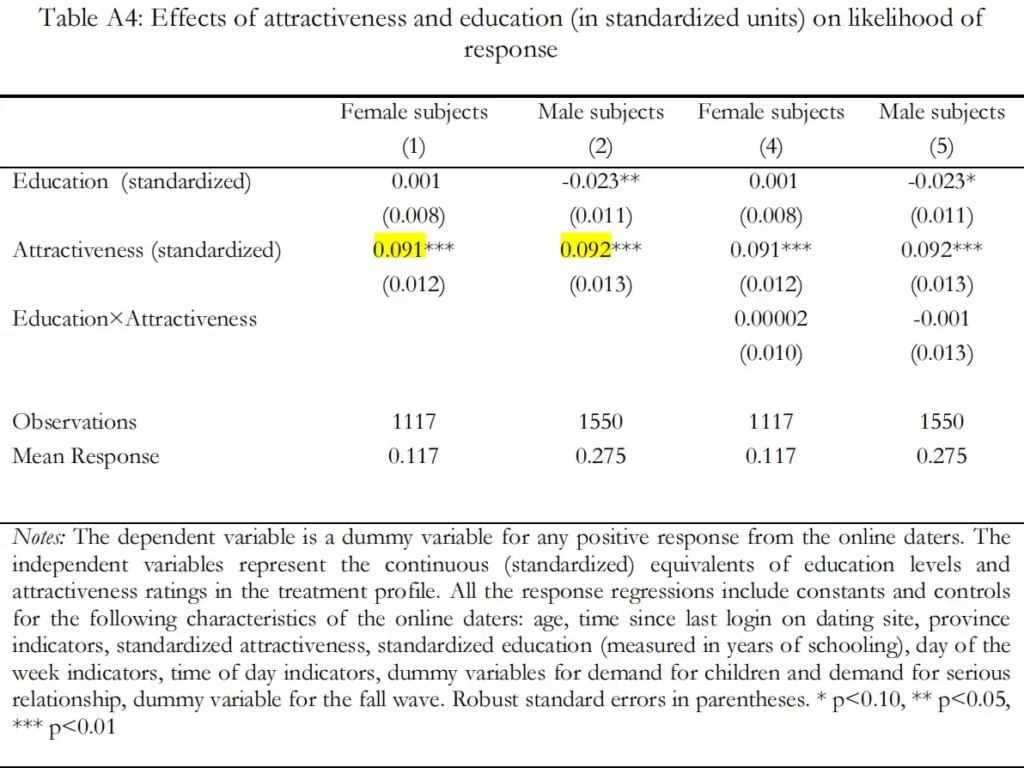
So we find that overall, while women’s role as the ‘selectors’ in the courtship process seems to largely carry over to the online dating world, it seems not to be the case that they are unique in what some would call their ‘hypergamous’ practices. When it comes to looks at least, both men and women tend to shoot above their weight to an extent. It’s not the case that men have no standards whatsoever while women are all saving their attention for the top 5%.
The same pattern is typically observed in speed-dating experiments, wherein while women tend to give out less ‘yesses’ to their speed-dating partners, they aren’t more concentrated in a smaller number of partners relative to the amount of yesses given, and the yesses men receive doesn’t correlate higher with their physical attractiveness than they do for women but in fact generally a bit lower.
Maybe this difference in selectivity therefore should be considered more of a difference in the nature of the strategies employed rather than simply a difference in attractiveness standards. Although there are no doubt certain domains in which women set higher minimum demands than men do on average, attractiveness doesn’t seem to be one of them (except perhaps when it comes to potential hookups), even in an environment in which you have little else to go off of and where you’d think they could afford to be more selective.
It would make sense evolutionarily speaking for women to adjust their standards according to their own mate value, as due to a limited fertility window, if they spent too long ‘chasing chad’, they risk their eggs drying up before producing any offspring, and generally the benefits of securing paternal investment from a less desirable man would’ve outweighed any potential benefits from ‘better genes’. This is probably why monogamous pair-bonding is the standard mating system universally across cultures, even in ones which permit polygamy.
We also saw that the median match rate on Tinder is similar for both men and women when accounting for the gender ratio. Maybe it’s the case that there’s a good deal of assortative mating occurring through online dating after all.
Actual online dating outcomes
None of the data so far has addressed what really matters. Swipes, matches, and messages all mean very little if they’re not actually leading to anything real, and what we really need to know to answer the question at hand is to know if it’s really the case that a minority of men are physically meeting up and having sex with a proportionally greater number of women.
The other graph from the earlier article I want to show displays the percentage of Millennial men and women who’ve met up with someone through Tinder before:
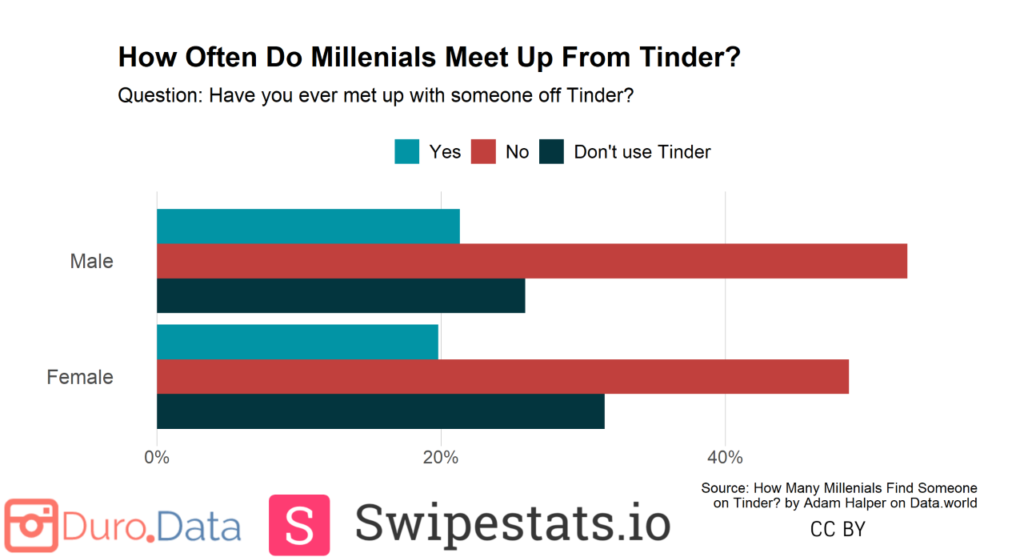
So what we find is that the actual proportions of men and women who’ve met up through Tinder are also essentially equal, with slightly more men having done so perhaps due to gay/bi men being more enthusiastic dating app enjoyers. This completely flies in the face of TTN, which would predict a proportionally greater number of women having met up with someone. It looks like the primary bottleneck is the skewed gender ratio after all. I could stop there, as as far as I’m aware there has never been any actual direct evidence for this narrative presented, it’s simply based on emotion and lazy extrapolations which ignore this inconvenient context, but in case this isn’t enough to convince you I have much more in the way of outcome-oriented data to share, as well as multiple other lines of evidence which I argue are incongruent with TTN.
A representative survey was conducted in 2017 by Rutgers, the Netherlands centre on sexuality, including 17,000 Dutch people between the ages of 18 to 80. Of 4,934 men and 8,216 women between the ages of 18-24, 15% of men and 13% of women had been on a date through online dating in the past 6 months, and 9% of men and 7% of women had had sex through one. Of 427 men and 687 women between the ages of 25-39, 10% of men and 7% of women had been on a date through online dating in the past 6 months, and 7% of men and 4% of women had had sex through it.

A study by Sumter et al. (2017), titled ‘Love me Tinder: Untangling emerging adults’ motivations for using the dating application Tinder’, was conducted among Dutch people between the ages of 18-30. Of the 163 subjects who were current or former Tinder users, 32 men stated they’d been on a tinder date while 40 stated they hadn’t. The numbers for women were 30 and 38 respectively. So about 44% of both men and women who’d used Tinder before (meaning somewhat more men). They were also asked whether they’d had a one-night stand through Tinder. 21 men said yes, while 52 said no. Only 5 women said yes, while 61 said no. This comes out to 28.8% of men and 7.6% of women.

So this time we see a wide gap, in the case of ONS at least. It feels like a stretch to attribute this to male homosexual encounters. The sample size wasn’t anything to write home about so it may simply be a product of random error, or maybe there’s some degree of social desirability bias affecting the responses to the hookup question. Let’s see what some other sources have to say.
Here we have a Swiss national survey on sexual health and behaviours conducted in 2017. Of 2,864 men and 2,746 women whose ages were all somewhere around 26, 17.6% of men and 18.7% of women stated they’d ever had a date with someone met on the internet. 30.4% of men and 24% of women stated they had several times. Overall these come to 48% and 42.7%.
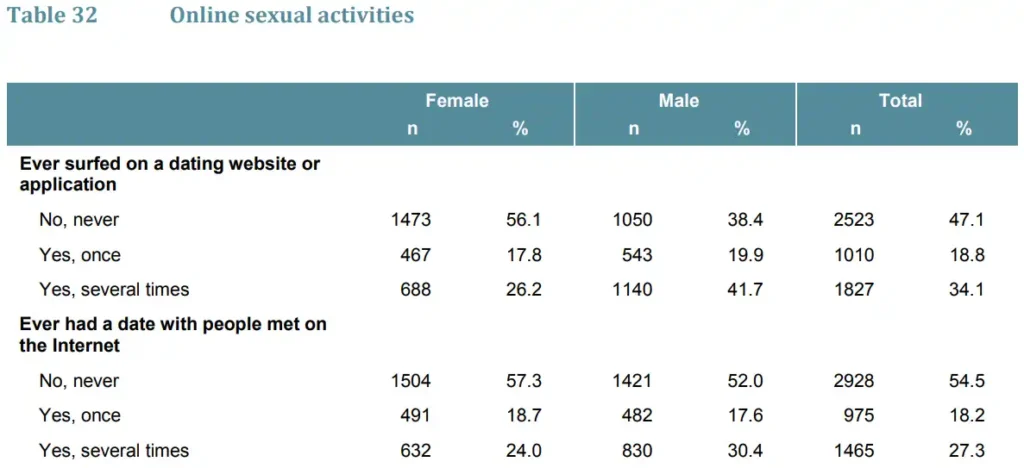
35.2% of men and 22.5% of women stated that they’d had sex through the internet before. More men either did this ‘sometimes’ or ‘often’.
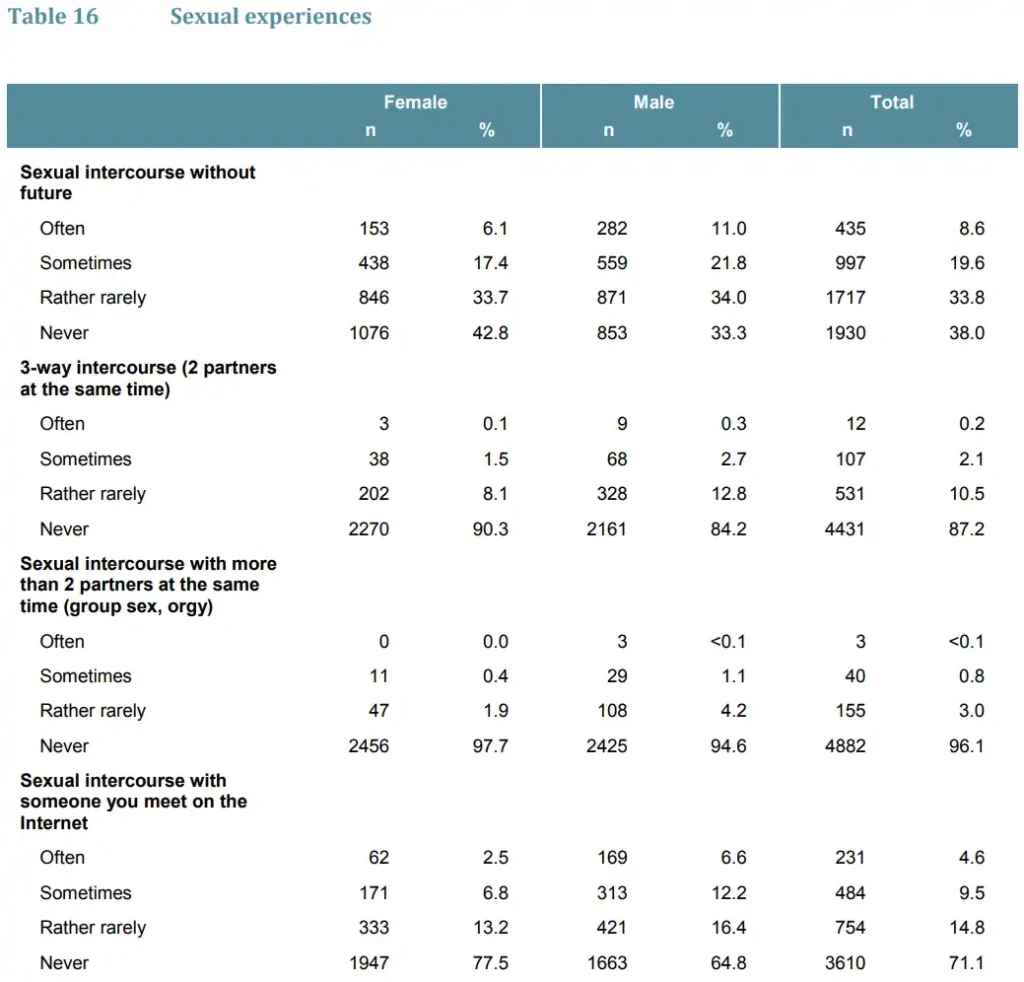
So going by these figures it’s also not the case that within these overall rates it’s more skewed for men, or that there are more women who had dated or hooked up with multiple guys than vice versa.
A Morning Consult poll of 1,061 men and 1,143 women in the US conducted in 2018 found that of those who’d used an dating app or service before, which was 31% of men and 28% women, 28% of men and 34% of women had met someone for one or more dates before. This would translate to 8.8% of men and 9.5% of women overall, slightly bucking the trend we’ve seen up until now. More men, 25%, than women, 21%, reported having met a long-term romantic partner through it though, and 20% of men and 8% of women reported having had a hookup through it before. This would translate to 6.2% of men and 2.2% of women overall.

This following graph is from data I’ve retrieved from a nationally representative US survey named the National Survey of Family Growth. In the 2017-19 survey cycle, they asked whether participants had had sex in the past year with someone they first met through online dating, which would presumably include partners they’d met in prior years. Of a large sample of 3,472 men and women between the ages of 18-29, 8.6% of heterosexual men and 7.4% of heterosexual women selected yes. The rates were a lot higher for homosexuals, especially men, presumably because 1. online dating is especially appealing to sexual minorities since it’s harder for them to meet partners in real life, and 2. sex differences in sociosexuality.
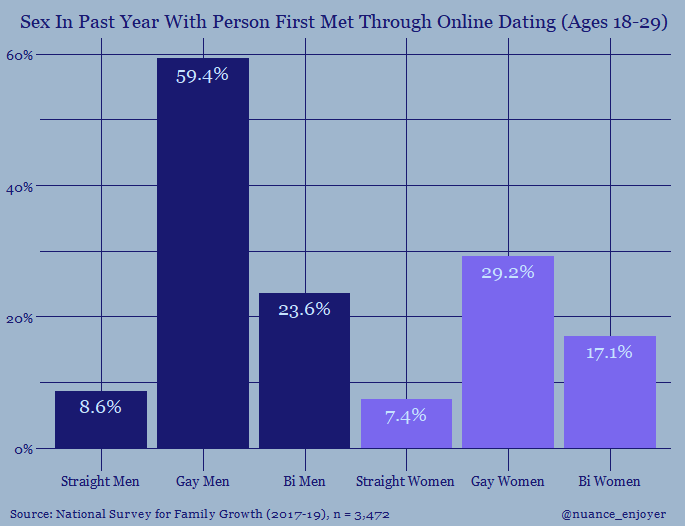
This study, titled: ‘Are Tinder and Dating Apps Changing Dating and mating in the U.S.?’ was conducted by Michael Rosenfeld – the same lead researcher behind the How Couples Meet And Stay Together 2017 survey and the associated study which has since been frequently cited as a demonstration of the growing dominance of online dating (there are some nuances worth going into there but that’s for another day).
Of 2,843 heterosexuals, only 1.4% of men and 1.3% of women had ‘met someone through a phone app in the past year for dating, romance, or sex’.
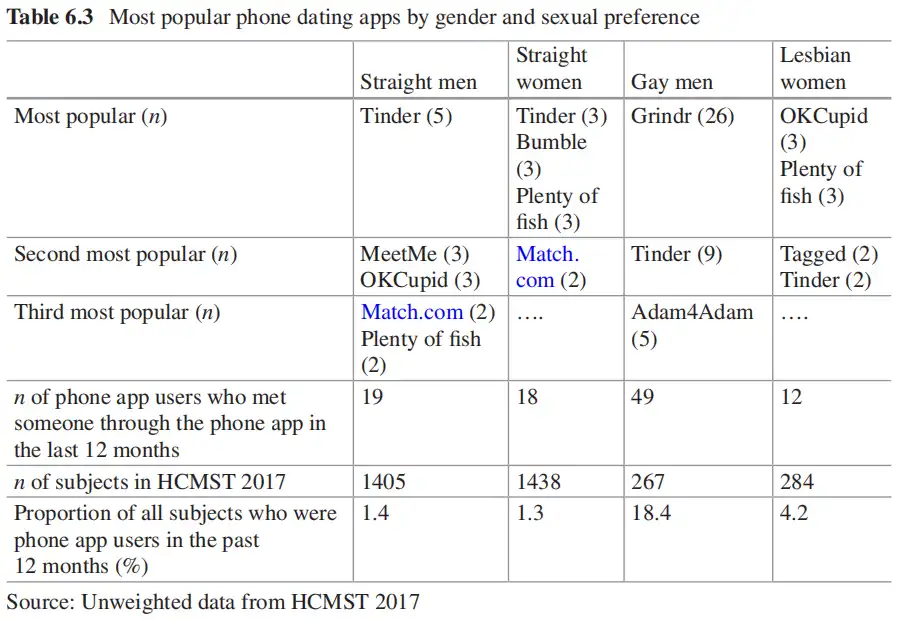
Of heterosexual men and women who cheated on their partners, or who were single and ‘met at least one person for dating, romance, or sex in last 12 months’, this was mediated by dating apps about 20% of the time.
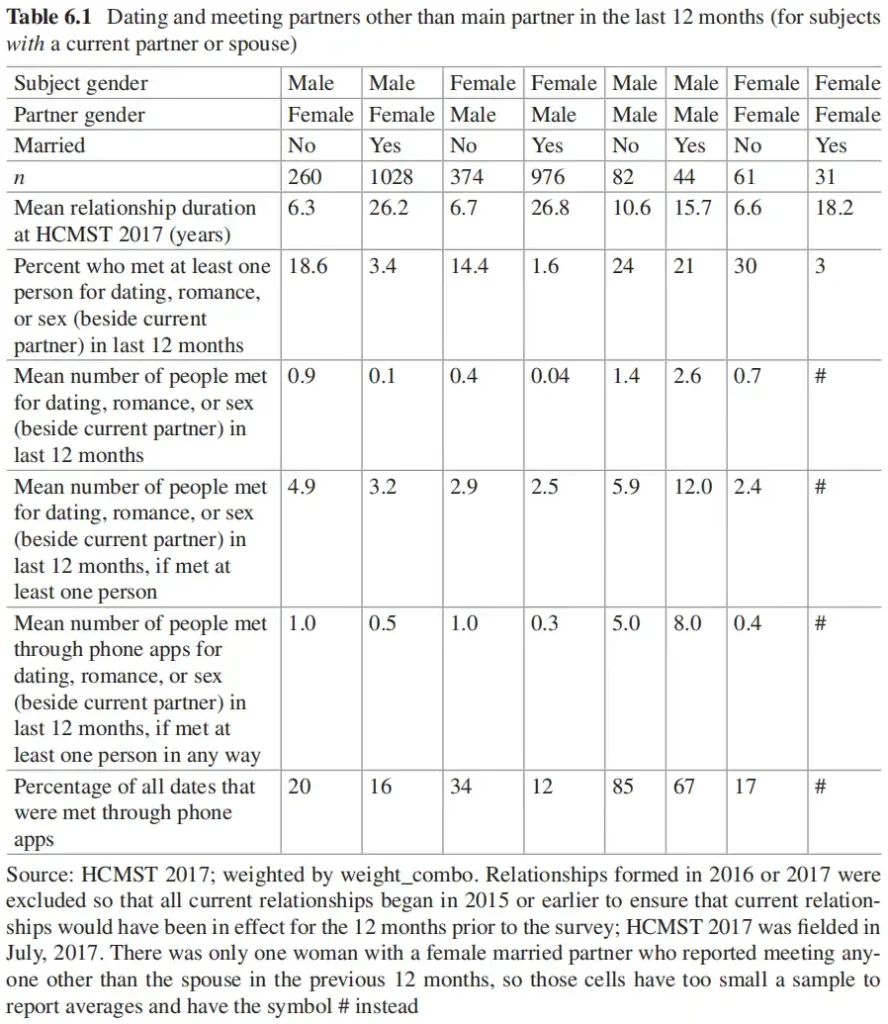
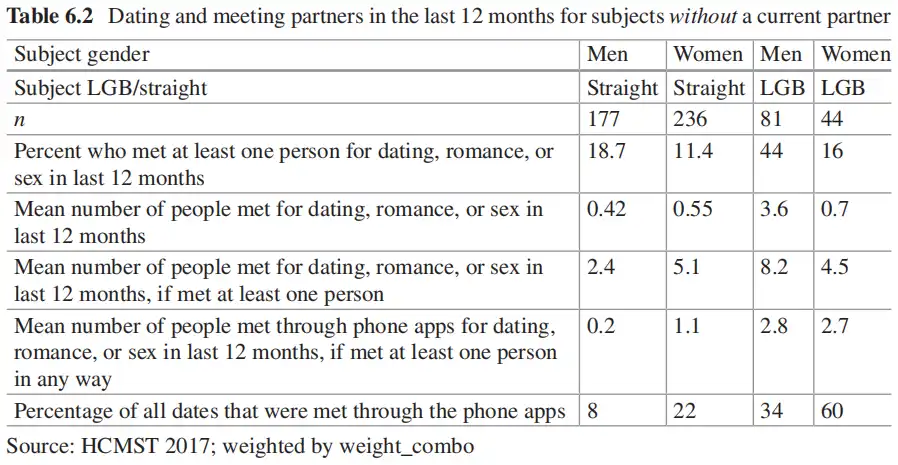
YouGov conducted a joint survey with BBC’s Newsbeat of 2,066 British 16-34 year olds.
It was found that 49% of males and 41% of females had ever used an online dating app or website.
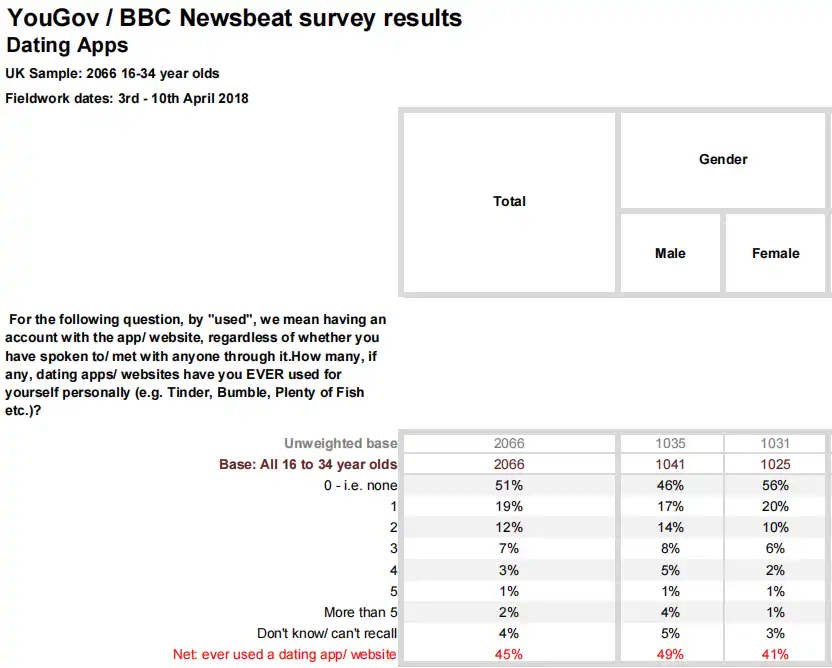
When it comes to the number of first dates they’d had through them, we see a very similar distribution between males and females. We don’t see a higher concentration among men, or more women who’ve had numerous unique dates through online dating.
According to this data, a good majority of males who’d used online dating had actually managed to achieve at least one date through it as well. 66% of male and 71% of female online dating users report ever having been on a date through it, for an overall total of 32% of males and 29% of females.
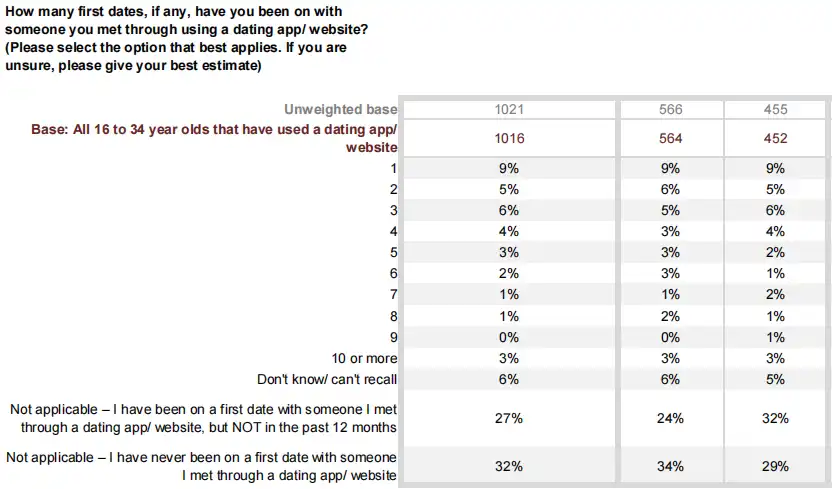
An American Perspectives Survey in 2020 found no difference in the amount of heterosexual 18-29 men and women who’d had a date through a dating app or website before. Both were close to 30%. Most of the women hadn’t even used online dating. A slight majority of men had, meaning that again a majority who had used it had also been on a date through it. It seems like it may not be a completely wasted effort for the average guy after all.
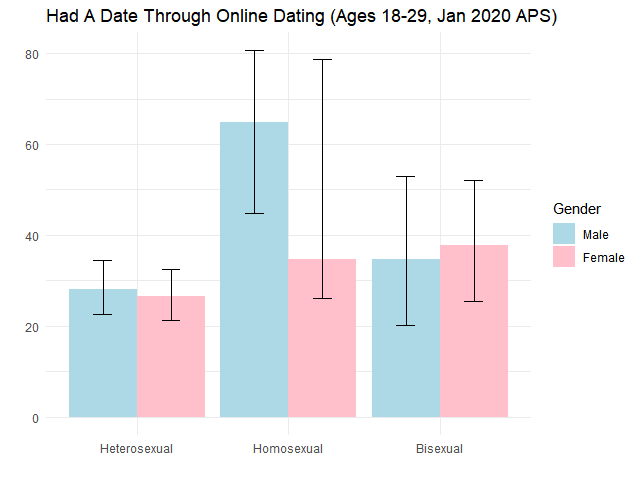
A study by Grøntvedt et al. (2020), titled: ‘Hook, Line and Sinker: Do Tinder Matches and Meet Ups Lead to One-Night Stands’, found that of 168 Norwegian women and 101 men with mean ages around 22, only about 20% of them had had a hookup through Tinder, about about 50-60% had met up with someone through it. This time, even weighting the categories of men and women, women did meet and hookup through Tinder slightly more, but not enough that can’t be explained by more men overall having used Tinder, or random error.
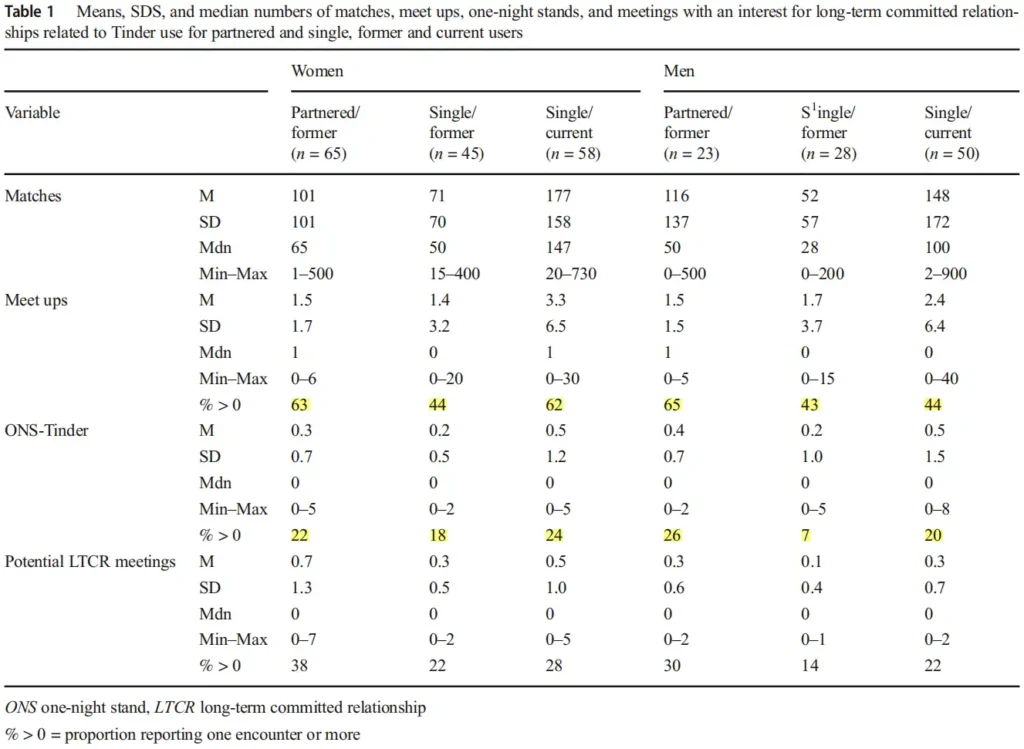
Some other interesting findings from the study:
- The matches to meet up ratio was 57:1, and the meet ups to ONS ratio was 5.4:1. This would imply that it takes 308 matches on average for a hookup to occur. The meet ups to meeting an LTR partner ratio was 5.1, implying that people are more likely to meet a partner than hookup through it, putting into question the notion that dating apps are facilitating ‘hookup culture’ at the expense of relationship formation.
- Of the 20% of Tinder users who’d had a sexual encounter through it, 13% just had one, while 3% had two, and 4% had more than two.
- Only 7 of 54 participants who reported having had one night stands had only had them solely through Tinder.
- Number of ONS outside of Tinder was only weakly associated with number of ONS following Tinder. This association disappeared after controlling for length of use and age, and even became negative after controlling for other factors.
- The participants’ self-perceived short-term mate value correlated at only 0.16 with ONS through Tinder and 0.12 with ONS outside of Tinder.
A study by Poerwandari & Berliana (2022) titled: ‘Dating apps and risky sexual behaviors among young adults in large cities in Indonesia’, found that among 158 men and 471 women between the ages of 18-30, 42% of women and 49.4% of men who’d used dating apps before had had sex through them before.
A study by Yu et al. (2022) analyzed data from the 2020 Chinese Private Life Survey. This table shows online hookup experience by birth cohort and educational level.
Other than the youngest (and oldest, though it had the lowest sample size by far) cohort, many more men reported having had experience. These are the biggest gaps seen yet, and may suggest that Chinese women, at least in older cohorts, feel more cultural pressure to keep their sexual behaviour undisclosed, but I’m not sure.
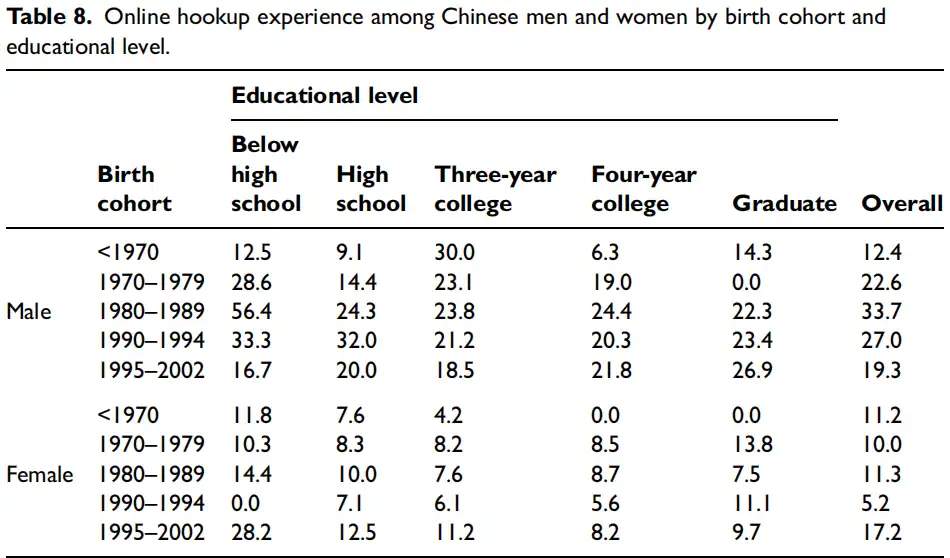
Finally, a study by Mohan (2023) found that among 5,190 Irish aged 20, 37.1% of males and 27.1% females had met up with someone they met online in the past year. This could mean social meetups as well (or I guess drug deals), but people who met someone offline had higher rates of dating app usage, non-heterosexuality, and sexual activity at age 17. The high rate of non-heterosexuality could help explain the discrepancy.
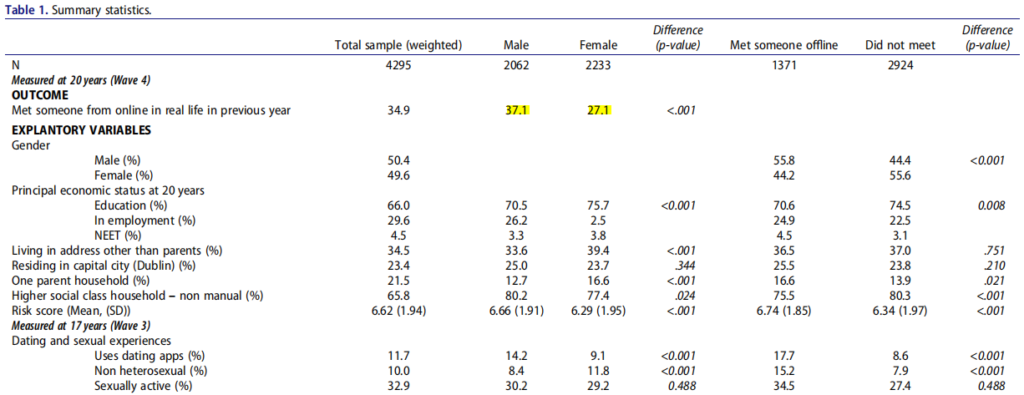
There we have it. Dating apps are not causing 80% of the women to be funneled to 20% of the men. Since men make up close to 80% of dating app users at any one time, if 20% of men had sex with 80% of the women, this would equate to 16% of app users having sex with 16% another 16% of them. We shouldn’t then be surprised to see that when we just look at the data on the outcomes themselves instead of relying on sketchy extrapolations from a stage in the process leading up to them, we don’t see the disparities that TTN would predict. I could say case closed and leave it there, but it’s always preferable to build a cumulative case covering as many angles as possible.
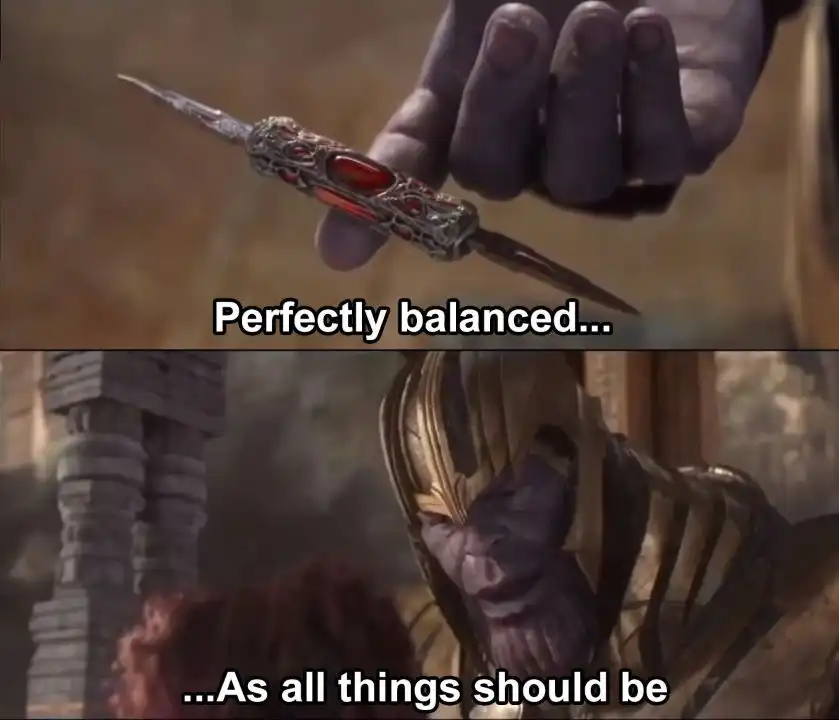
Sex partner data
So what about that top 20/5% then, did the introduction of dating apps cause the rich to get richer and their ‘monopolies’ to grow? Is the implication of this meme correct?
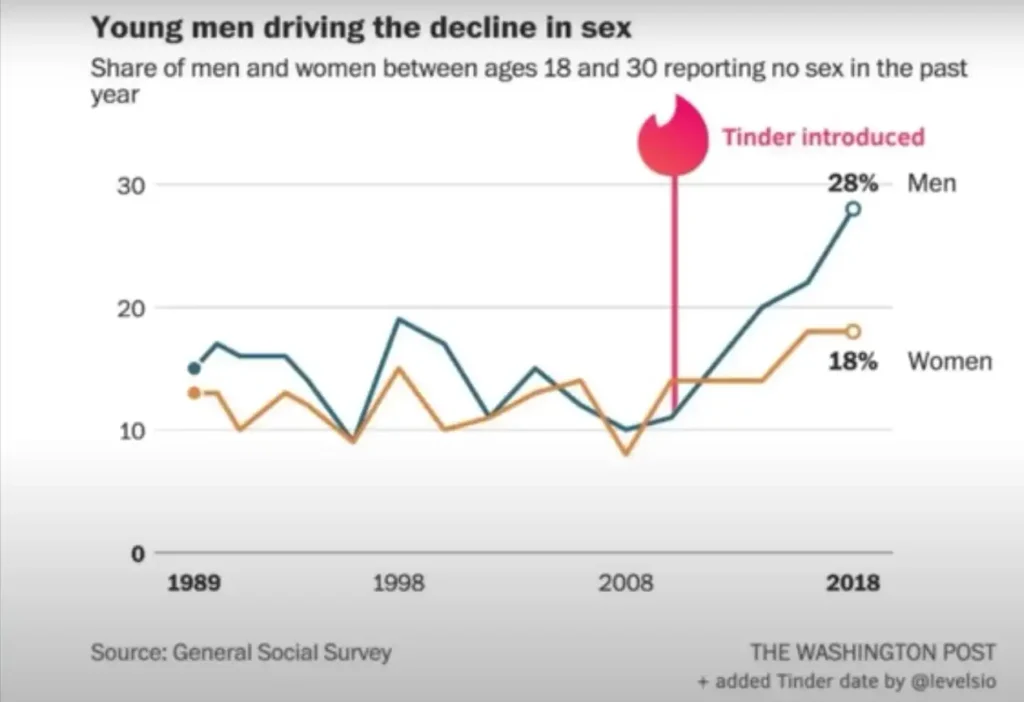
In a study by Buyukeren et al. (2022), titled ‘The Causal Effects of Online Dating Apps: Evidence From U.S. Colleges’, they analyzed data from the National College Health Assessment following the introduction of Tinder to see how it affected the sexual and romantic lives of college students in fraternities and sororities (who were the main target audience of Tinder for their early promotion strategy). Here is the most relevant finding, showing the number of extra sex partners accrued following the introduction of Tinder divided by quartiles representing the number of sex partners they were predicted to have otherwise:
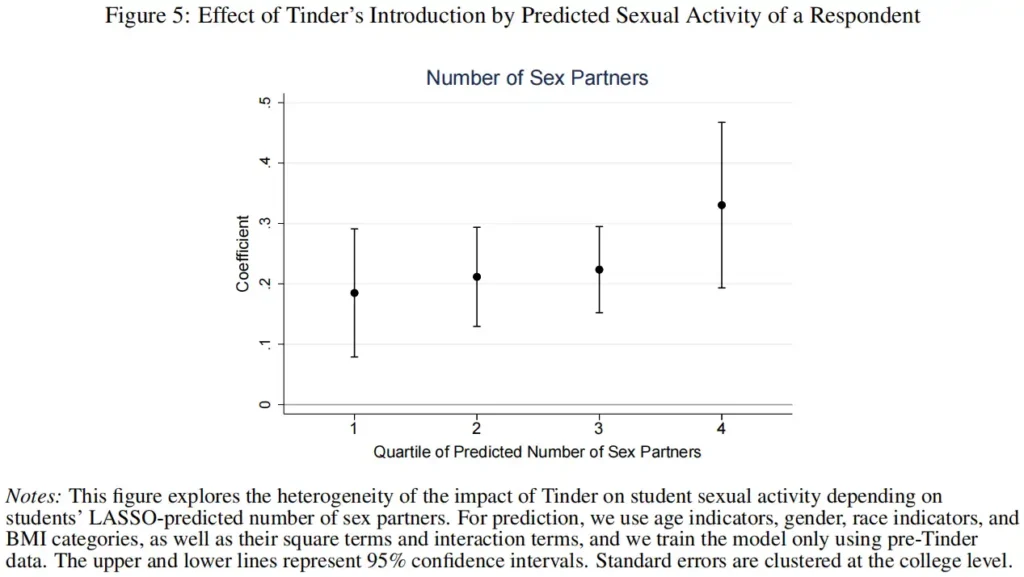
We see that it apparently did have an impact, but while it may have amplified the sexual success of the top quartile the most, it seems to have also provided the rest with a boost as well. The effect also wasn’t dramatic. While the bottom quartile gained what looks like 0.19 sex partners in the past year, the top gained 0.33.
I’ve also arranged some nationally representative survey data to examine whether the top 80th and 95th percentiles when it comes to lifetime sex partners have been accumulating more sex partners in the dating app era.
First off we have the General Social Survey (the same source the graph in the above meme employed):
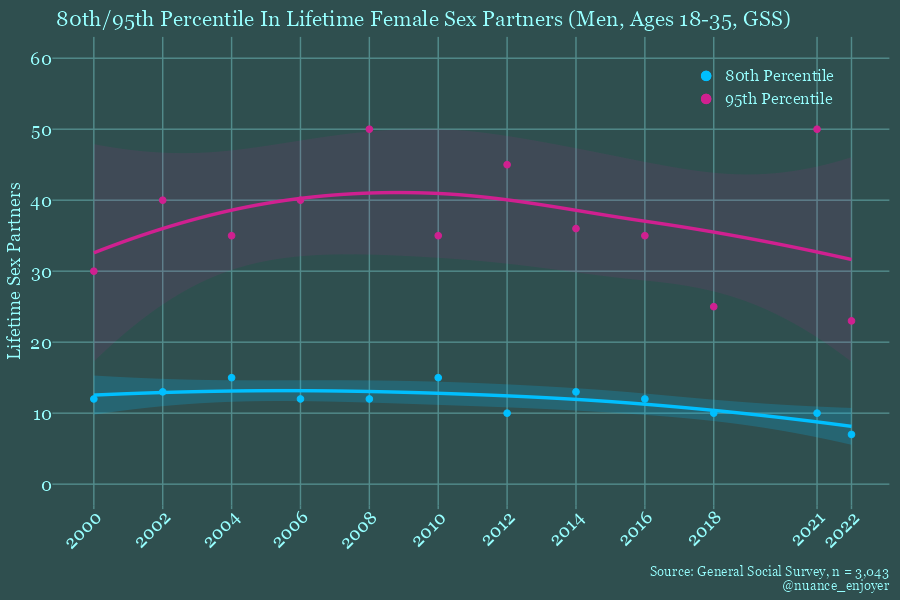
The sample size for this survey is quite limited, so I increased the upper age bound to 35. We still see a spike in 2021 which is probably just a blip. Other than that, contrary to TTN, if anything ‘chad’ has been dropping the ball lately. We see overall a downward trend in reported lifetime sexual partners following the introduction of dating apps in both the 80th and 95th percentile.
Next we again turn to the NSFG survey. There was a study by Harper et al., 2017, titled: ‘Changes in the Distribution of Sex Partners in the United States: 2002 to 2011-2013’, which concluded from comparing NSFG data from those years that there was an increasing concentration of sexual activity among a minority of men. However, in accordance with the findings from the GSS, we do not see evidence for an increasing ‘chadopoly’ when we include the subsequent three surveys, even after limiting it to the more relevant age range of 18-29, but if anything a chadcession:
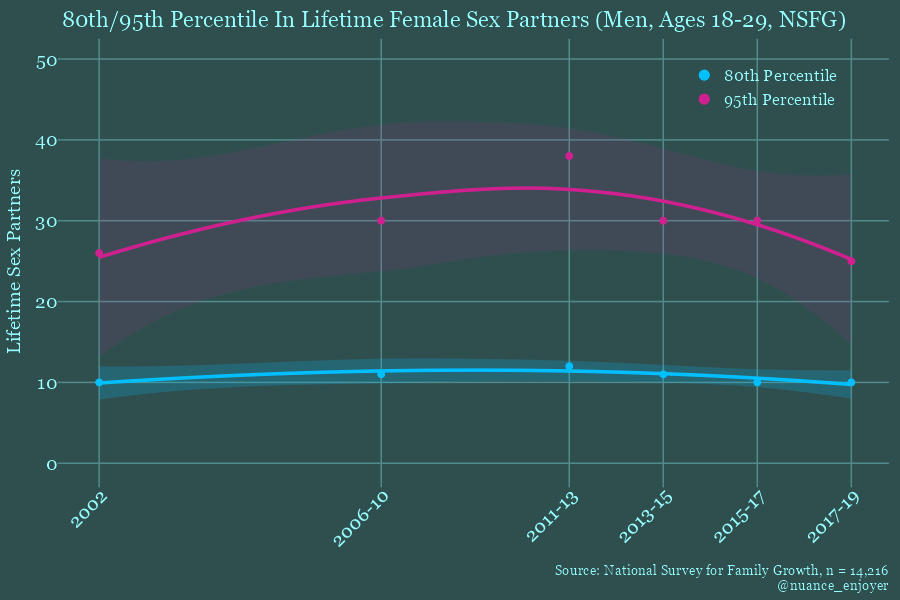
For good measure here is data from the National Health and Nutrition Examination Survey, although the sex data past 2016 unfortunately remains inaccessible to the public:
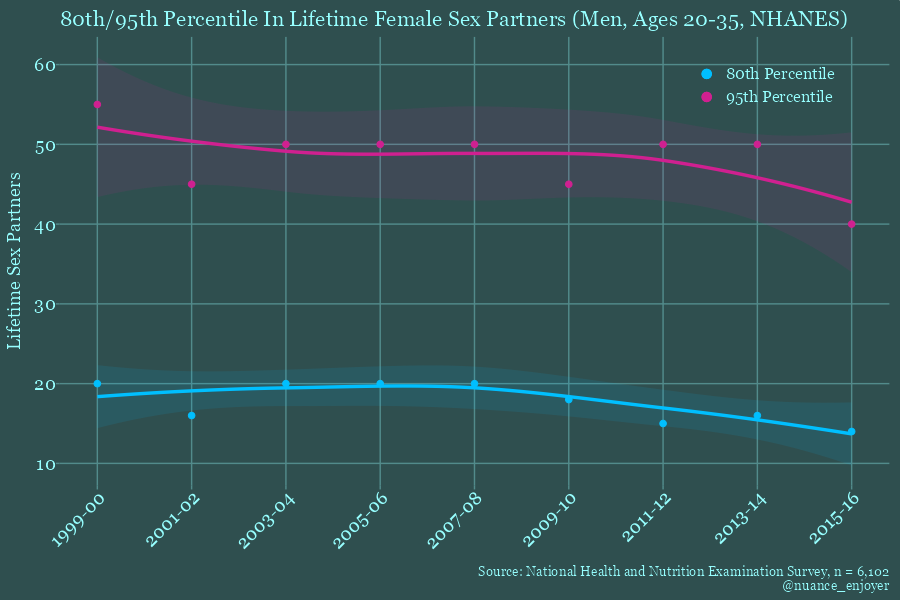
It appears then that ‘chad’ (assuming that we can even call the men represented by this data that when physical attractiveness only weakly correlates with sexual experience) is not immune to the social forces influencing the reduction in sexual activity among the general population.
So how about that GSS graph showing a male driven sexlessness trend then? Like I said, the GSS sample size is nothing to write home about, especially when you narrow it down to subsamples like 18-30 men who answered the sex questions. This allows for a good amount of noise, especially when you factor in the weighting by age. The number of 18-30 men who answered the ‘sexfreq’ question that the Washington Post used and that all the catastrophic extrapolations were being made from was a mere 136. 20 were 18-20, while 36 were 28-30. The youngest respondents experienced a spike which then caused an inflation in the overall rate after it was weighted up.
This is why we shouldn’t be shocked to see that the trend reversed in the next two surveys:
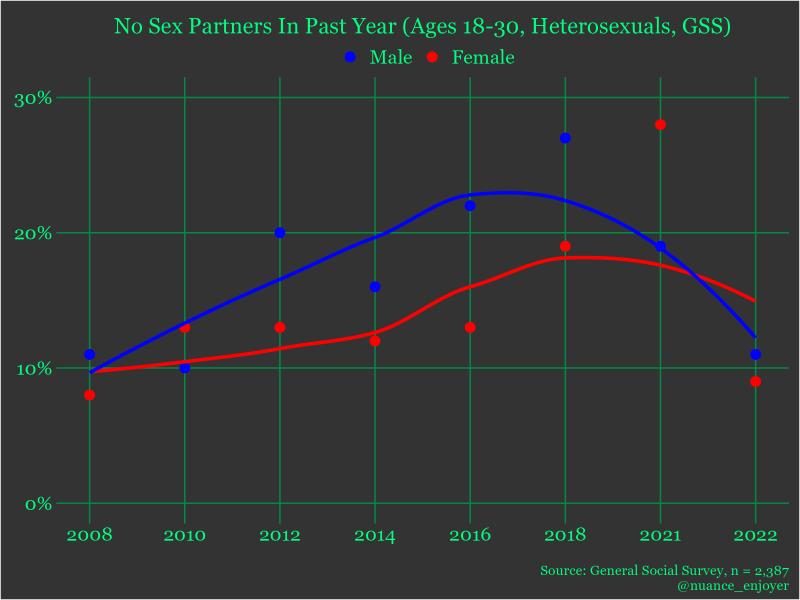
When we again return to the NSFG, whose sample size for respondents between the ages of 18-29 completely dwarfs the GSS one between the same timespan of 2008-2018 by over 10x, we see that there was never good evidence for a gendered sexlessness trend, and we also see a more tame trend overall, as the rate began higher than the GSS one, and ended lower.
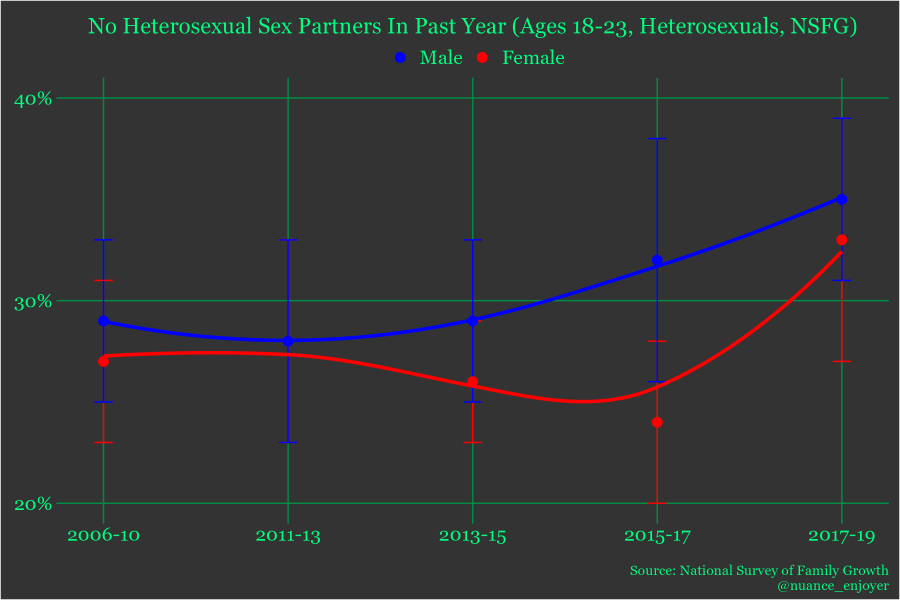
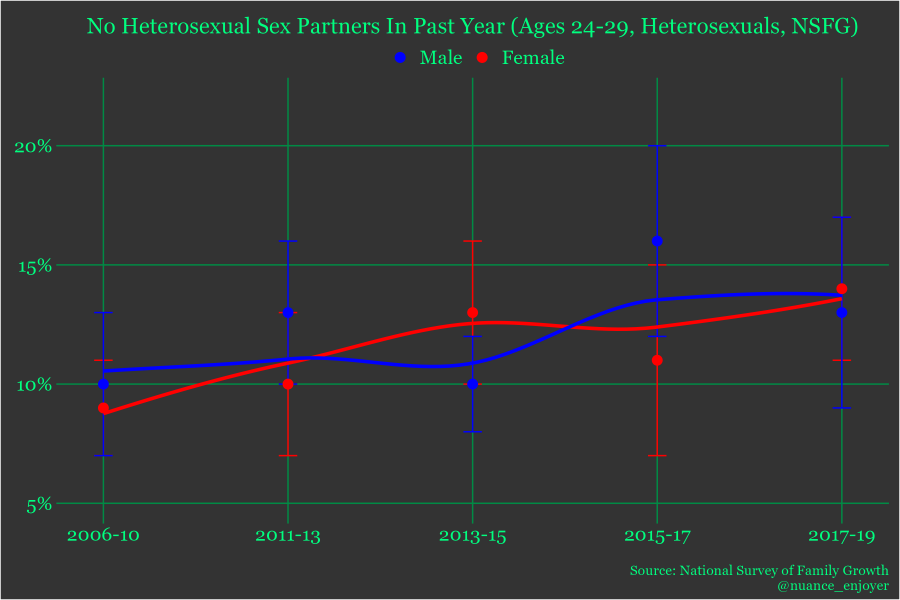
The data for virginity was further still from the GSS graph, as this survey asks directly whether the respondent had had heterosexual vaginal intercourse before, while with the GSS you have to rely on an imperfect proxy. The one that the Washington post graph used, ‘number of female sex partners since turning 18 (including in the past 12 months)’, didn’t just inflate the rate because there were respondents who’d had a sex partner before but not since turning 18 (or in the past year), but also because they failed to limit the sample to heterosexuals while the question pertained specifically to opposite-sex sex partners.
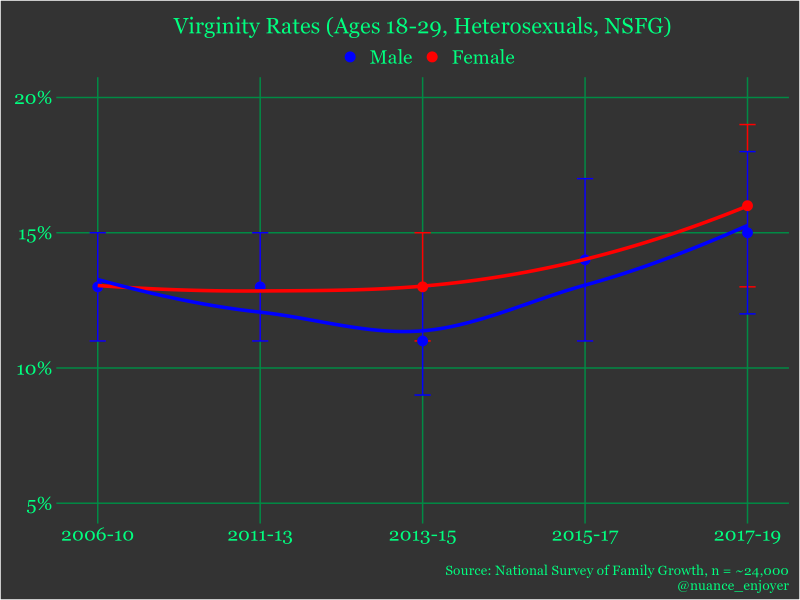
The GSS also measures height and looks, at least on certain years. Height was measured in the 2014, 2018, and 2022 surveys. Looks was measured on a 1-5 scale in 2016 and 2018. Here are the combined results:

Only the looks and sex partners in the past year effect achieved statistical significance, though even here the effect is weak at best. It was actually lower in 2018 than in 2016, though this is probably just random error.
Still, maybe in the past it wasn’t even present. This small effect could still be the result of dating apps, right? It seems like no, it’s basically the same as it’s been for decades. For instance, a study by Bogaert & Fisher Bogaert & Fisher, 1995, titled: ‘Predictors of University Men’s Number of Sexual Partners’, found a (not quite significant) correlation of .2 between physical attractiveness and lifetime sex partners (this would only explain 4% of the total variance), and .28 between physical attractiveness and maximum sex partners in one month.
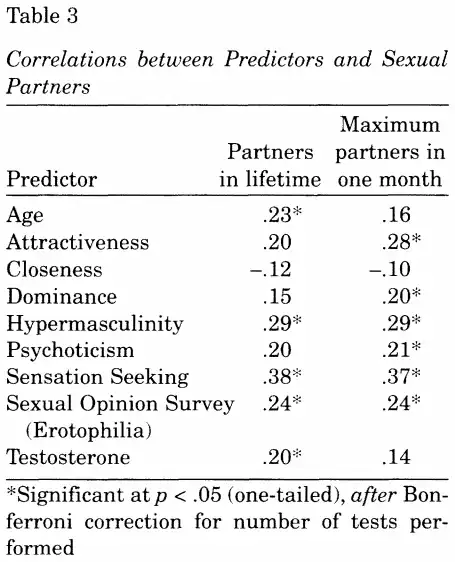
So no, there does not appear to have been a ‘consolidation of mating’ among an ‘elite minority’ following the introduction of dating apps. The men having the most sexual encounters aren’t having any more than they were before (but if anything less), there’s likely not been increasing ‘sexual inequality’ between the genders either as both have experienced a (modest) rise in sexual inactivity, and the vast majority of the variance in sexual experience remains at least as unaccounted for by physical attractiveness as it was three decades ago, while height remains basically irrelevant (although to be fair other sources with larger sample sizes tend to show a trivial but nonetheless significant correlation of about .05 with lifetime sex partners).
“But we can’t trust self-reported data!”
I’m not so naive as to think this will be adequate to convince skeptics (to the extent that any evidence against this almost religious dogma will be enough). Many for instance will protest on the basis of this data being self-reported. It’s hard to imagine how this would affect trends (or lack thereof) over time, unless you also believe that there’s good reason to think that men are feeling more pressure over time to downplay their licentiousness. Maybe when it comes to the dating app outcome data they feel more pressure to deny having hooked up than men do though. That seems somewhat plausible at least, especially considering we saw some gaps there that this explanation may help in filling. On the other hand it seems less plausible for reported meet ups, but I guess it’s possible that some stigma exists around meeting people through online dating.
There’s good reason to think that answers to sexual questions though, especially in more anonymous conditions, are relatively reliable.
In a study by Alexander & Fisher, 2003, study titled ‘Truth and consequences: Using the bogus pipeline to examine sex differences in self-reported sexuality’ for instance, the answers given in the anonymous condition didn’t significantly differ from those given in the condition wherein participants were made to believe they were being monitored by a lie detector.

There’s a way we can bypass the dubious reliability of self-reports altogether however. This is by looking at STD cases. The STD statistics don’t lie. The first thing to note is that the probability of contracting an STD rises exponentially the more sex partners that are involved in the network.
This chart provides a visual representation of this phenomenon:
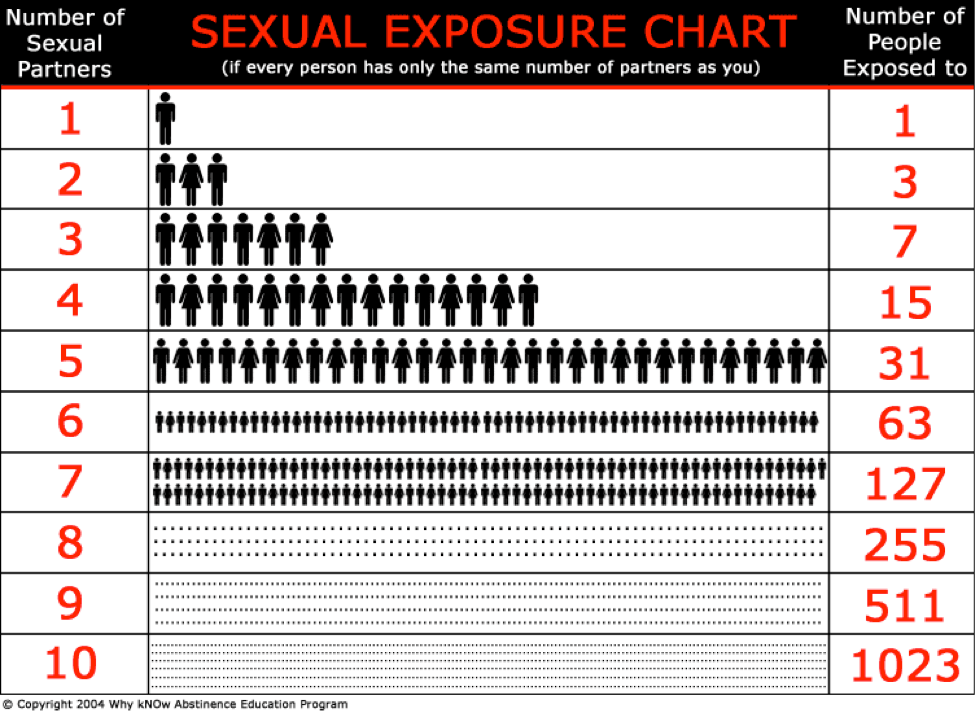
If it were the case that a minority of men were engaging in promiscuous activity with a majority of women, we should expect to see higher rates of STDs among women. A ‘carousel’ sounds inviting, but really we’re talking about an STD factory.
Now let’s get to the data. Below is CDC data on Syphilis & Gonorrhea cases among men and women. MSW means exclusively heterosexual men. Not only do we not see much difference in the STD rates between this group and women, but their trends leading up to 2019 follow each other very closely.
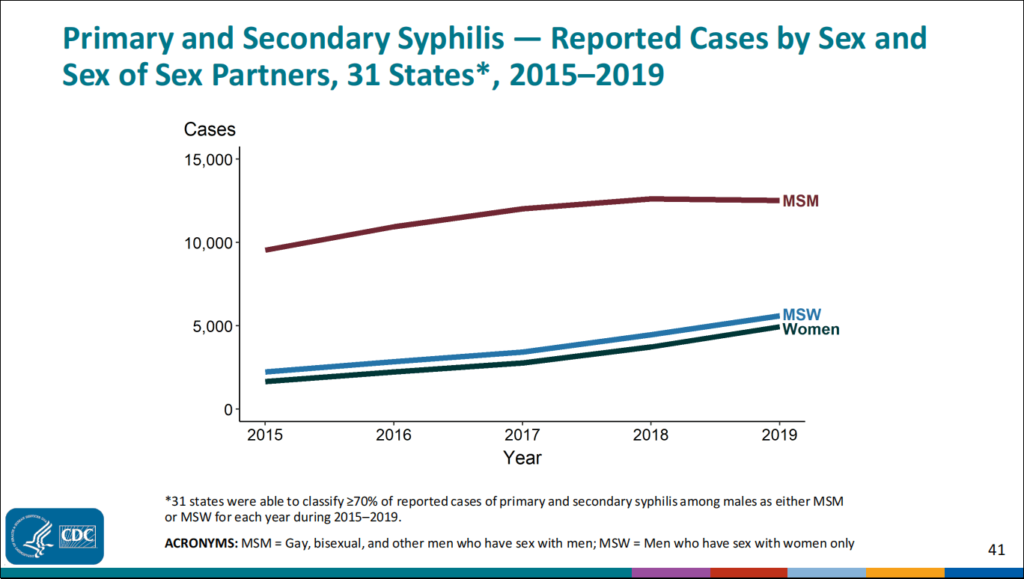
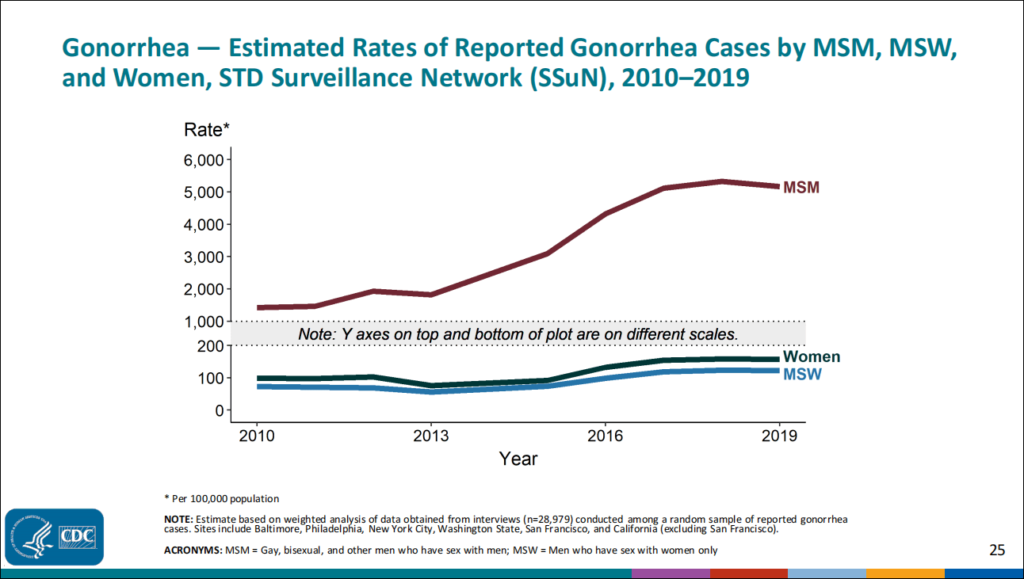
In the case of Chlamydia, while we still see similar trends, women do have significantly higher rates even than men overall:
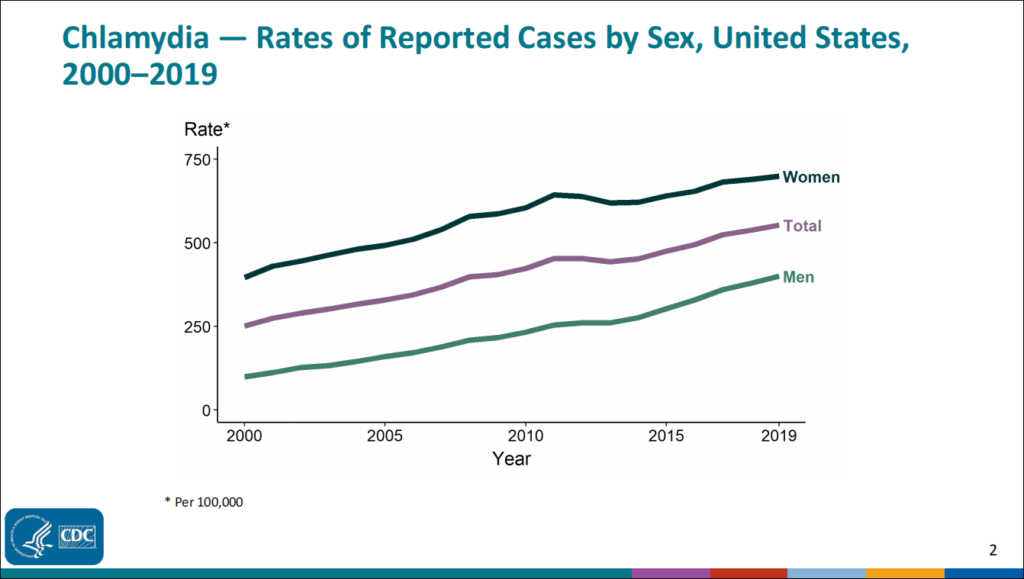
You might say this lends credence to the notion of ‘soft polygamy’ even if there’s no sign of a widening of the gap following the introduction dating apps, but there is a simpler explanation in that due to women suffering more severe sequelae (consequences), it was decided that routine screening should be limited to young women.

Another thing you might say is that rising STD rates seems to contradict the previous finding that the most promiscuous men are reporting if anything less sex partners in more recent years, but the director of the CDC’s Division of STD Prevention states that the actual cause for this trend lies not in the amount of sex people are having, but rather the increase in risky practices such as foregoing condoms and ‘high-risk sexual behaviors associated with opioid use and addiction’: https://www.theatlantic.com/family/archive/2018/08/why-are-stds-on-the-rise-if-people-are-having-less-sex/568909/
So all in all it looks like the ‘promiscuous 10%’ have remained that way. We aren’t seeing women approach the STD levels of gay men as TTN would predict.
Most men quite like online dating
Another finding which may surprise people considering where most of the complaining about online dating seems to come from, is that men report a more positive experience with (and sentiment towards) online dating than women do. In the latest Pew survey on online dating, 57% of men reported at least a positive experience with dating apps or websites compared to 48% of women.
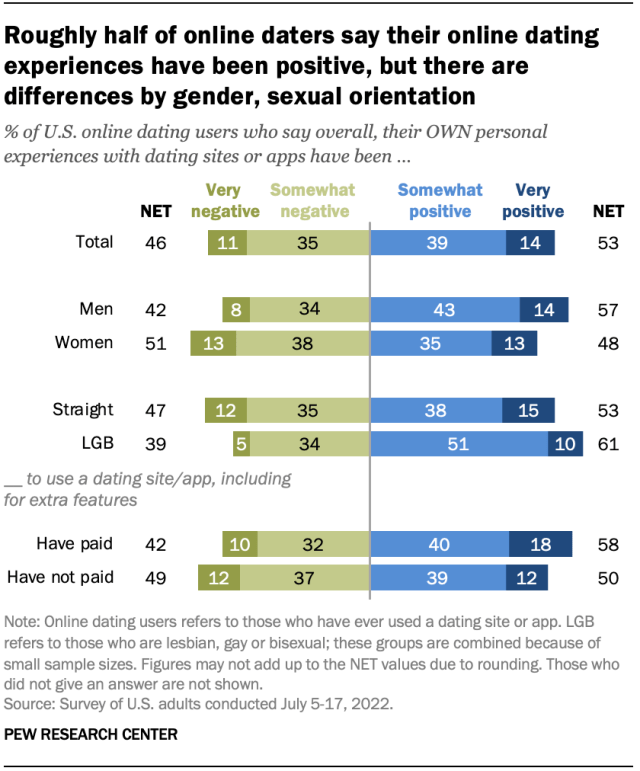
A similar pattern is seen in these 2021 Morning Consult results. 60% of men compared to 43% of women reported an at least somewhat positive experience with dating apps or services.
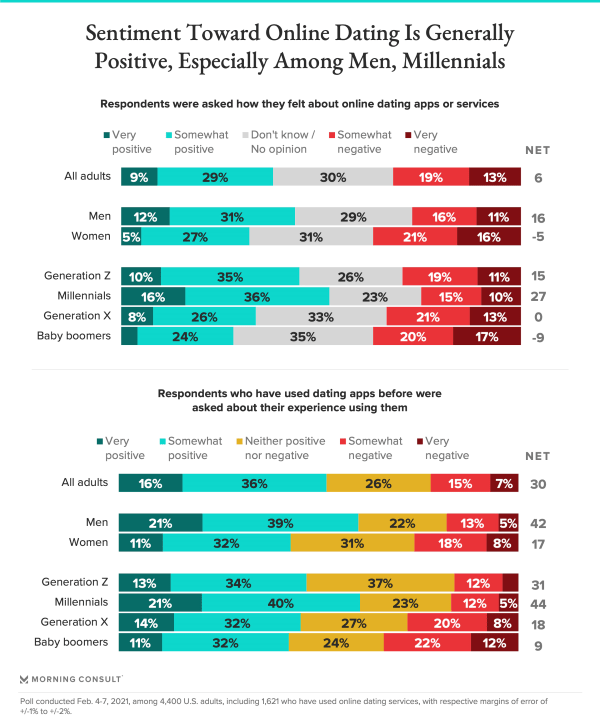
And also in these 2021 YouGov results. Though few men or women seem to prefer online dating to more traditional ways of meeting, 44% of men stated either that they’d prefer to meet their partner through online dating or that they had no preference, compared to 29% of women.

Of course when it comes to the negative experiences, the reasons will be different for men and women. Nonetheless, these results don’t suggest that online dating is a miserable self-esteem devastating hellscape for most men and a blessing from heaven for women.
Having a lot of options to choose from may sound good on paper, but there exists a psychological phenomenon which is sometimes named ‘decision paralysis’, whereby when you have ‘too many’ options it paradoxically becomes harder to make a decision, to where you may be too mentally drained to make one at all, and if you do you may feel less satisfied with it.
Why should we even expect this?
There’s a question as to how much of this narrative stems from a failure to understand how male and female sexuality actually differs. Many incels seem to share a conception of women as being essentially gay men, but just a lot more picky. They believe that they are driven just as much as men by sexual lust, with at least as much of a desire to hookup, but that this energy is simply focused on a narrower portion of the opposite sex. They view women’s easy access to sex as a highly enviable privilege, and that so-called ‘hookup culture’ is something that is to the benefit of women and ‘chads’, as women are free to do what they really want: to sleep around with an endless supply of hot guys who in turn are happy to engage in twelvesome orgies every day with all sorts of women, even homely ones he’d never be caught dead with in public (even when it comes to male sexuality this is a caricature at best).
Of course this vision of women as being sex-crazed nymphomaniacs (probably not helped by media like sex in the city or sex-positive feminists who deny these differences as they view them as justifying ‘slut-shaming’ etc.) is out of touch with reality. There’s a large body of research which shows that women on average have lower sex drives, are less open to casual hookups than men, are less aroused by sexual stimuli, etc.
Maybe if more people were aware of orgasm gap and more importantly how pronounced it is in the context of hookups, they’d be less quick to assume that women get just as much out of sex for its own sake as men. It’s probably the case that women have a higher need for emotional connection to be as aroused as men, and this may have developed because securing commitment is more crucial to their reproductive success. Then of course you have the risk of pregnancy on top of this. They’re just generally not a great deal for women.
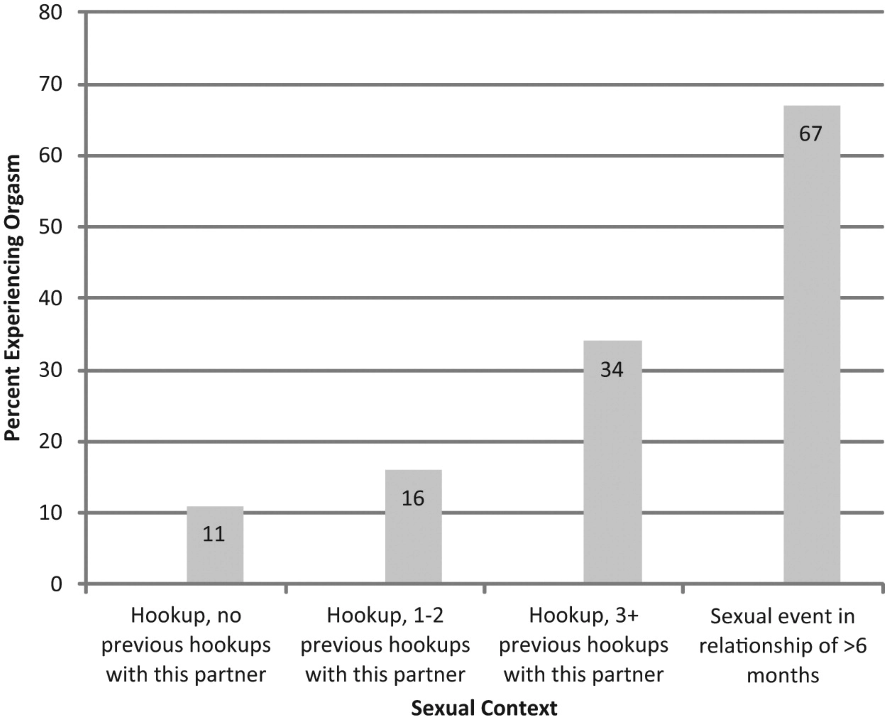
So it’s not clear to me why we’d expect this ‘cock carousel’ meme to begin with. While again it is true that the vast majority of women can have sex at the drop of a hat, the main reason for this is precisely because by and large they don’t have this desire. Some would respond to this by saying that ‘well if the guy is attractive enough then maybe a mid girl will make an exception, or be deluded into thinking she has a shot at securing commitment with him’ or something along those lines, and I have already admitted that men probably lower their standards when it comes to hookups (as they’re low investment with high potential reproductive payoffs). However even if this seems plausible in theory, the data I’ve presented simply doesn’t allow this to be a widespread occurrence.
Another problem with the narrative is that it has been well over 50 years since the sexual revolution and the introduction of the pill. What was stopping at least the ’80/20′ dynamic from emerging in the meantime? To bump into a top 20% man, that would take a total of five encounters. Why do we need modern technology to facilitate this? Especially if we’re to believe this is the ‘natural’ sexual marketplace which emerges in the absence of ‘enforced monogamy’. Elephant seals after all do not require phones to conduct their mating practices.
Conclusion
My purpose here wasn’t to promote dating apps or to say they’re actually a lot better for the average guy than you think. There are certain facts about them that are undeniable. Clearly they are no all you can eat pussy buffet, but I don’t know naive you’d have to be to have expected otherwise. That aside though, online dating is certainly much ‘harder’ for men, and this likely reflects the real world situation to a degree. It’s also probably getting a bit harder in general, what with increasing atomization and so on. What I deny is that this is because of a chadspiracy. Despite the trendiness of this meme, it remains completely evidence-free, and I believe that I’ve built a comprehensive cumulative case against it.
I know it’s appealing to attribute your problems to dating apps, but it’s hard not to see this as a cope when a strong majority of young men are sexually active in spite of them. If they relied purely on dating apps then this probably wouldn’t be possible. Since they are still reasonably socially active and have adequate social skills they don’t need to. Denying that these are real barriers is the real cope (even if you believe ‘chad’ can bypass them).
I know that people also like to link the recent Pew relationship statistics to this meme, but even if those numbers were accurate (unlikely), I can also rule the chadspiracy out as an explanation for them, but this article is probably already bloated enough as it is.
To summarize:
- Dating apps are male dominated environments, meaning they’re going to be a losing game for most men almost by definition. I left possible causes for this unexplored here but I have a number ideas as to why this may be.
- The median match rate for men and women is equal when controlling for this.
- Online dating studies show a similar effect of desirability/attractiveness for men and women.
- Data from many different sources and countries show a high degree of balance in actual outcomes by gender, i.e. meeting up, hooking up, finding partners.
- The men with the most ‘sexual success’ (80th and 95th percentile in lifetime sex partners) have not been reporting higher ‘notch counts’ since the advent of dating apps, but if anything less, in line with a broader reduction in sexual activity.
- There is not a growing gap in sexlessness between young men and women (even if there was, this could also be explained by women increasingly choosing to date up in age).
- The correlation between physical attractiveness and sexual experience in men is still weak and hasn’t risen from where it was three decades ago.
- Anonymously self-reported sexual behaviours are probably decently reliable in an anonymous condition, but if you want to dismiss them then you still have to contend with the fact that STD rates have not risen disproportionately among women since dating apps were introduced.
- Contrary to the popular notion that dating apps are uniquely terrible experiences for men, men seem to like the medium more than women (probably partially explaining the gender skew).
- The notion that women would even desire this is probably largely a projection of male sexual fantasy.
- There’s no obvious reason why the ’80/20′ dynamic couldn’t have emerged in the decades between the sexual revolution/advent of the pill and the introduction of dating apps.
- The Gender Ratio
- The Effects Of Attractiveness
- Actual Outcomes
- “But We Can’t Trust Self-Reported Data!”
- Most Men Quite Like Online Dating
- Why Should We Even Expect This?
- Conclusion
References
Morning Consult (2020). National Tracking Poll #200473, April 22-24, 2020. https://morningconsult.com/wp-content/uploads/2020/04/200473_crosstabs_CONTENT_CORONAVIRUS_Adults_v2_JB.pdf
Morning Consult (2018). National Tracking Poll #180111, January 18-20, 2018. https://morningconsult.com/wp-content/uploads/2018/02/dating-crosstabs.pdf
Ogury (2018). Dating App Study, Oct-Dec 2018. https://ogury.com/wp-content/uploads/Dating-Study_Oct-Dec-2018.pdf
App Ape (2021). https://www.statista.com/statistics/975925/us-tinder-user-ratio-gender/
Gerrard, B. (2021). “Why Do Women Have the Upper Hand on Tinder?”. The Bold Italic. https://thebolditalic.com/the-two-worlds-of-tinder-f1c34e800db4
Lee, L., Loewenstein, G., Ariely, D., Hong, J., & Young, J. (2008). If I’m not hot, are you hot or not? Physical attractiveness evaluations and dating preferences as a function of one’s own attractiveness. Psychological science, 19(7), 669–677. https://doi.org/10.1111/j.1467-9280.2008.02141.x
Rudder, C. (2009). “Your Looks and Your Inbox”. OKCupid. https://web.archive.org/web/20100725135317/http://blog.okcupid.com:80/index.php/your-looks-and-online-dating
Bruch, E. E., & Newman, M. E. J. (2018). Aspirational pursuit of mates in online dating markets. Science advances, 4(8), eaap9815. https://doi.org/10.1126/sciadv.aap9815
Egebark, J., Ekström, M., Plug, E., & Van Praag, M. (2021). Brains or beauty? Causal evidence on the returns to education and attractiveness in the online dating market. Journal of Public Economics, 196, 104372. https://doi.org/10.1016/j.jpubeco.2021.104372
Todd, P. M., Penke, L., Fasolo, B., & Lenton, A. P. (2007). Different cognitive processes underlie human mate choices and mate preferences. Proceedings of the National Academy of Sciences of the United States of America, 104(38), 15011–15016. https://doi.org/10.1073/pnas.0705290104
Van Lisdonk, J., & Nikkelen, S. W. C. (2018). Seksuele oriëntatie (chapter in Dutch monitor Sexual Health in the Netherlands 2017). ResearchGate. https://www.researchgate.net/publication/322939647_Seksuele_orientatie_chapter_in_Dutch_monitor_Sexual_Health_in_the_Netherlands_2017
Sumter, S. R., Vandenbosch, L., & Ligtenberg, L. (2017). Love me Tinder: Untangling emerging adults’ motivations for using the dating application Tinder. Telematics and Informatics, 34(1), 67–78. https://doi.org/10.1016/j.tele.2016.04.009
Barrense-Dias Y, Akre C, Berchtold A, Leeners B, Morselli D, Suris J-C. (2018). Sexual health and behavior of young people in Switzerland. Lausanne, Institut universitaire de médecine sociale et préventive, 2018 (Raisons de santé 291). http://dx.doi.org/10.16908/issn.1660-7104/291
Rosenfeld, M. (2018). Are Tinder and dating apps changing dating and mating in the USA? In J. Van Hook, S. M. McHale, & V. King (Eds.), Families and technology (pp. 103–117). Springer Nature Switzerland AG. https://doi.org/10.1007/978-3-319-95540-7_6
YouGov/BBC Newsbeat (2018). https://d25d2506sfb94s.cloudfront.net/cumulus_uploads/document/mv1fnnhj8v/YG-Archive-030318-BBCNewsbeat.pdf
Grøntvedt, T. V., Bendixen, M., Botnen, E. O., & Kennair, L. E. O. (2020). Hook, line and sinker: Do Tinder matches and meet ups lead to one-night stands? Evolutionary Psychological Science, 6(2), 109–118. https://doi.org/10.1007/s40806-019-00222-z
Poerwandari, Elizabeth Kristi and Berliana, Cintia (2022) “Dating apps and risky sexual behaviors among young adults in large cities in Indonesia,” Psychological Research on Urban Society: Vol. 5: No. 2, Article 3. DOI: 10.7454/proust.v5i2.145
Yu, J., Luo, W., & Xie, Y. (2022). Sexuality in China: A review and new findings. Chinese Journal of Sociology, 8(3), 293-329. https://doi.org/10.1177/2057150X221114599
Gretta Mohan (2023) Characteristics and behaviours of young people who meet online contacts face-to-face, International Journal of Adolescence and Youth, 28:1, DOI: 10.1080/02673843.2023.2241524
Buyukeren, B., Makarin, A., & Xiong, H. (2022). The Causal Effects of Online Dating Apps: Evidence From U.S. Colleges. MIT Sloan Research Paper No. 6833-22. http://dx.doi.org/10.2139/ssrn.4240140
Bogaert, A. F., & Fisher, W. A. (1995). Predictors of university men’s number of sexual partners. Journal of Sex Research, 32(2), 119–130. https://doi.org/10.1080/00224499509551782
Alexander, M. G., & Fisher, T. D. (2003). Truth and consequences: using the bogus pipeline to examine sex differences in self-reported sexuality. Journal of sex research, 40(1), 27–35. https://doi.org/10.1080/00224490309552164
Centers for Disease Control and Prevention (2019). Sexually transmitted disease surveillance 2019. https://www.cdc.gov/std/statistics/2019/std-surveillance-2019.pdf
Qu, Z., Azizi, A., Schmidt, N., Craig-Kuhn, M. C., Stoecker, C., Hyman, J. M., & Kissinger, P. J. (2021). Effect of screening young men for Chlamydia trachomatis on the rates among women: a network modelling study for high-prevalence communities. BMJ open, 11(1), e040789. https://doi.org/10.1136/bmjopen-2020-040789
Vogels, E. A. & McClain, C. (2023). “Key Findings about Online Dating in the U.S.”. Pew Research Center. https://www.pewresearch.org/short-reads/2023/02/02/key-findings-about-online-dating-in-the-u-s/
Meyers, A. (2021). “Spurred On by COVID-19, Millennials Lead the Way in Destigmatizing Online Dating”. Morning Consult. https://pro.morningconsult.com/articles/online-dating-stigma-amid-pandemic
Ballard, J. (2021). “What are Americans looking for on dating apps?”. YouGov. https://today.yougov.com/society/articles/36300-dating-apps-poll-data
Cox, D. A., Lee, B. & Popky, D. (2022). “Politics, Sex, and Sexuality: The Growing Gender Divide in American Life”. American Survey Center. https://www.americansurveycenter.org/research/march-2022-aps/
Armstrong, E. A., England, P., & Fogarty, A. (2012). Accounting for women’s orgasm and sexual enjoyment in college hookups and relationships. American Sociological Review, 77(3), 435–462. https://doi.org/10.1177/0003122412445802
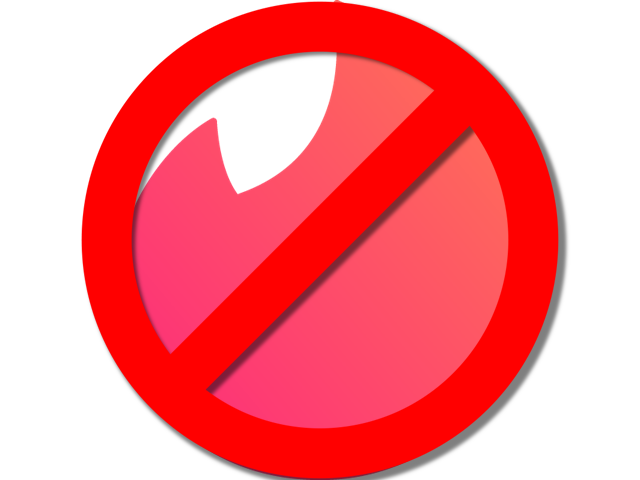
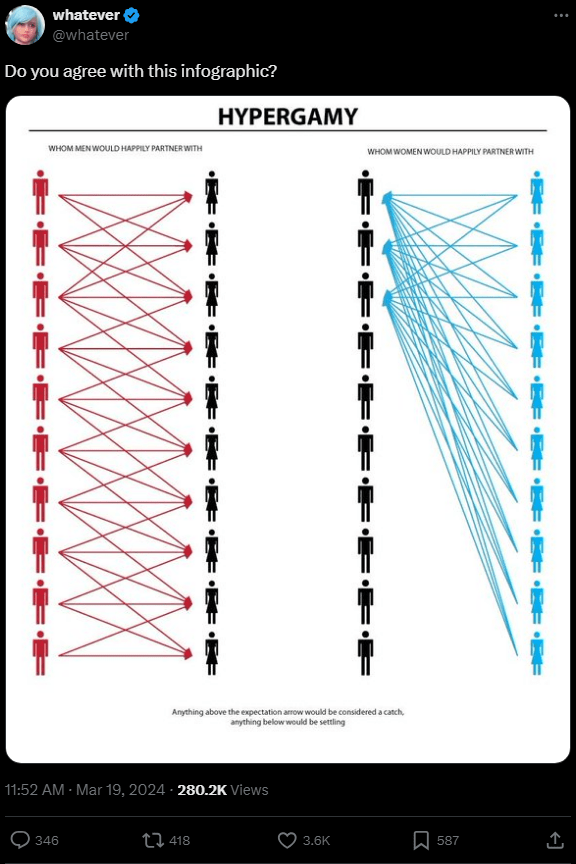
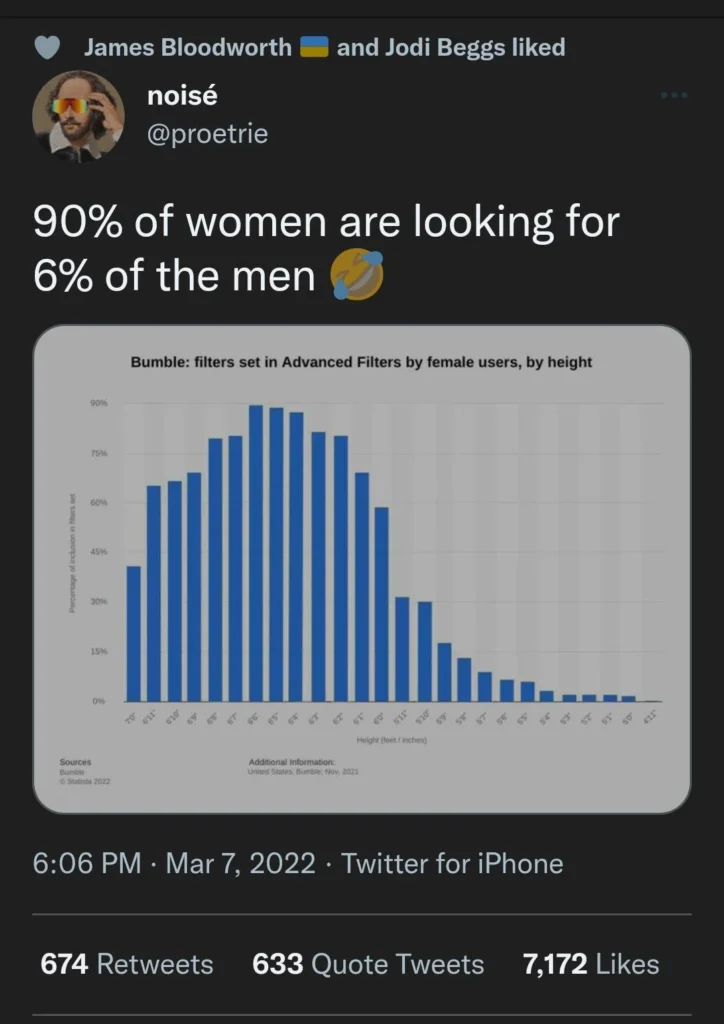
I love your wp format, where did you get a hold of it?
Interesting website, i read it but i still have a few questions. shoot me an email and we will talk more becasue i may have an interesting idea for you.
This is nonsense. What are you even trying to say? That the experience for the average man on dating apps sucks because there’s more men than women on there?
That does play a factor. But let’s say there’s 3 times as many men on dating apps than women, which is the number you took. This doesn’t mean that men only get 1/3 as many matches as women. It’s more like 1/1000 or something crazy low.
Have you ever made a profile with an average woman on tinder vs. an average man? You will notice the man gets NO matches while the woman gets HUNDREDS a day. It’s common knowledge. You’re spamming meaningless studies from the 2000s that aren’t valid anymore. This isn’t the 2000s. The incel phenomenon didn’t even exist then or on a much smaller scale. Just look at the slope of the graph that shows men’s sexlessness over the past few decades. It stops at 2018, so take the gradient and do the math for 2024.
Also EVERYONE uses online dating these days. It’s not just tinder and other regular dating apps but even more so Instagram and other social media. And you can make an argument the more attractive you are, the more followers you gain on these platforms and therefore the more success you have in dating.
You might have understood if you weren’t fuming too much properly read and process it. You’d also be aware that the data for male sexlessness doesn’t actually stop at 2018, you just haven’t been exposed to the more recent data because it doesn’t serve the narrative.
can’t afford to pay for the study by Grøntvedt et al. (2020), titled: ‘Hook, Line and Sinker: Do Tinder Matches and Meet Ups Lead to One-Night Stands’ but I wanna know how the numbers for hook ups etc. look when controlled for actual frequency of use and amount of desire to fuck someone through the app.
Length of use correlated with ONS at .27. Sociosexual attitudes correlated at .24 and sociosexual desires correlated at .11. In the final model, the effect of length of use was only marginally significant, sociosexual attitudes was highly significant, and sociosexual desires remained non-significant.
I am interested to know why you believe I have been rejected by women following first dates despite me being several points higher than them in terms of physical attractiveness.
The fact that women’s match rate is still higher than men’s despite being far more selective (swiping right on less than 10% of men compared to men swiping right on 50% of women) should tell you everything.
Hello my loved one I want to say that this post is amazing great written and include almost all significant infos I would like to look extra posts like this
Attractive section of content I just stumbled upon your blog and in accession capital to assert that I get actually enjoyed account your blog posts Anyway I will be subscribing to your augment and even I achievement you access consistently fast
Magnificent beat I would like to apprentice while you amend your site how can i subscribe for a blog web site The account helped me a acceptable deal I had been a little bit acquainted of this your broadcast offered bright clear idea
What i do not understood is in truth how you are not actually a lot more smartlyliked than you may be now You are very intelligent You realize therefore significantly in the case of this topic produced me individually imagine it from numerous numerous angles Its like men and women dont seem to be fascinated until it is one thing to do with Woman gaga Your own stuffs nice All the time care for it up
This is really interesting, You’re a very skilled blogger. I’ve joined your feed and look forward to seeking more of your magnificent post. Also, I’ve shared your site in my social networks!
I do agree with all the ideas you have introduced on your post They are very convincing and will definitely work Still the posts are very short for newbies May just you please prolong them a little from subsequent time Thank you for the post
Полностью важные события индустрии.
Важные мероприятия всемирных подуимов.
Модные дома, бренды, гедонизм.
Лучшее место для стильныех хайпбистов.
https://fashionsecret.ru